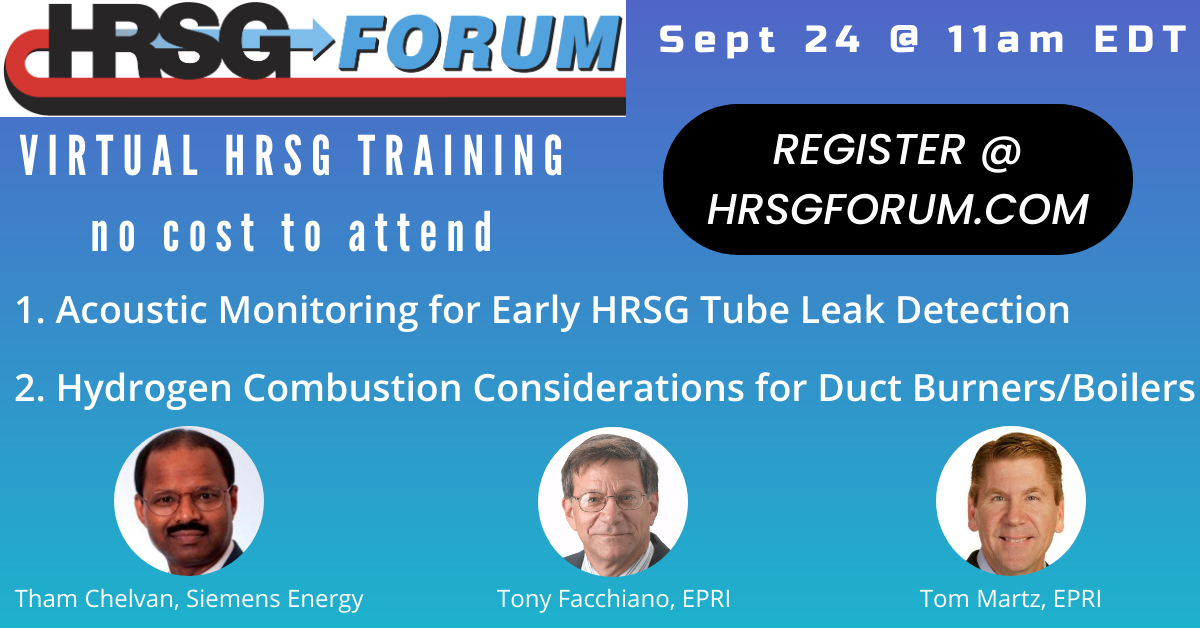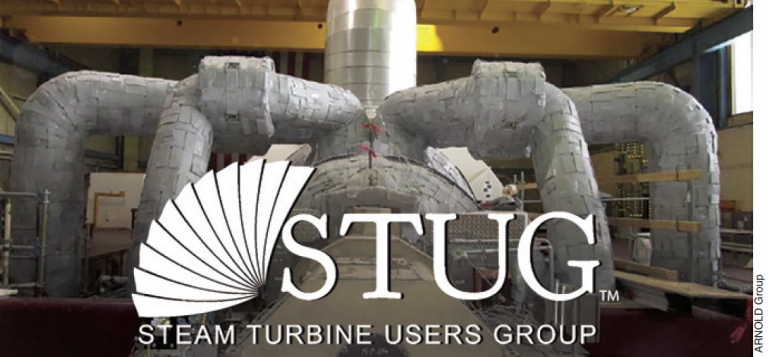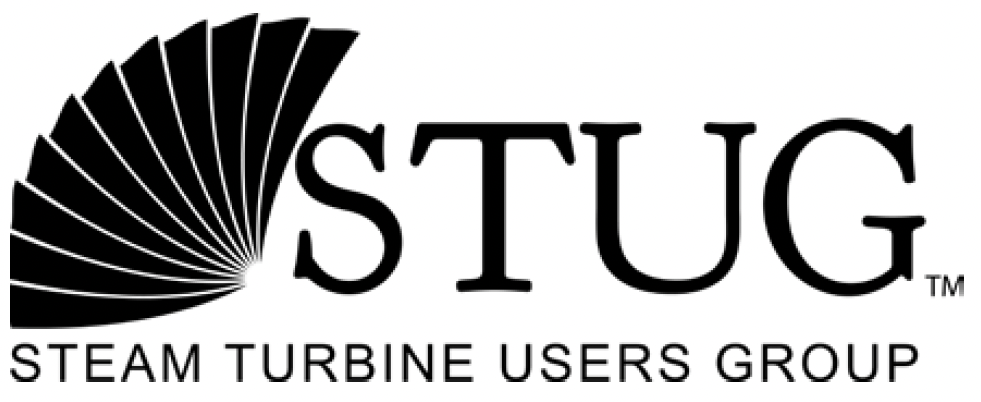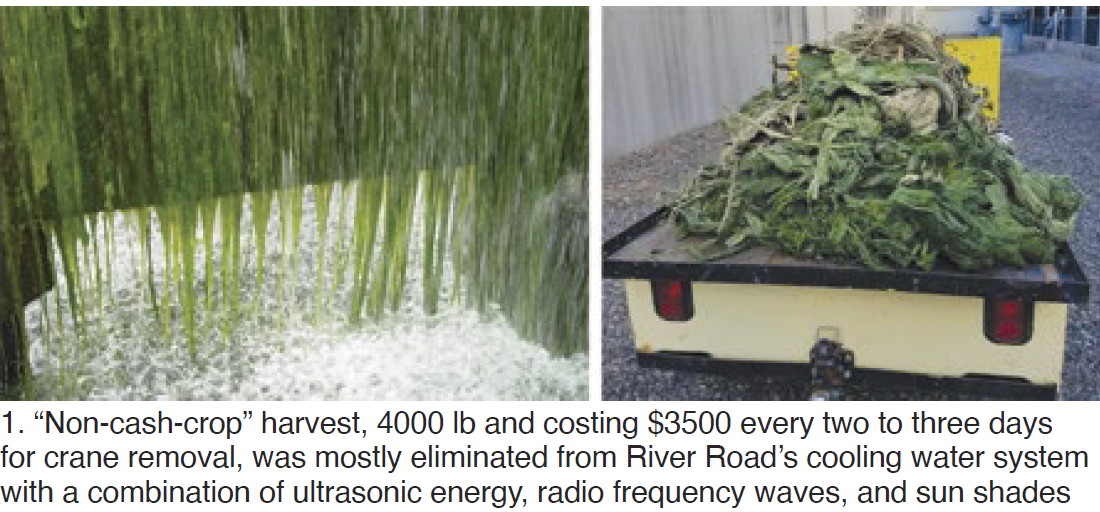
A combination of ultrasonic energy, AM radio-frequency waves, and sun shades managed to tame severe algae growth in the cooling tower at River Road Generating Station, according to Operations Manager Justin Hartsoch, GE Gas Power O&M. He told participants in the 2021 conference of the Combined Cycle Users Group (virtual) that algae blooms became a problem after the plant was compelled to shift from chloride to a bromine-based treatment to meet EPA NPDES regulations.
In a moment of levity, Hartsoch called the collected algae a “non-cash crop” (Fig 1), but also noted that the plant’s “unique algae bloom is seasonal.” Well water is the source for the plant.
 The biocide formula that was being used also fed on silica, creating resistant algae which would coat the forebay trash screens, and require cleaning every two to three days. So, the plant undertook a campaign to identify a non-chemical approach to algae control. The solution to date (“the story is not over,” Hartsoch said) has proved to be the following:
The biocide formula that was being used also fed on silica, creating resistant algae which would coat the forebay trash screens, and require cleaning every two to three days. So, the plant undertook a campaign to identify a non-chemical approach to algae control. The solution to date (“the story is not over,” Hartsoch said) has proved to be the following:
-
- Adding floating-head ultrasonic transducers at key locations throughout the cooling-tower basin.
- Installing nursery sun shades on three faces of the tower to deprive algae of the sunlight necessary for growth.
- Installing radio-frequency devices on each of the circulating- and service-water lines.
Details of this unique cooling water treatment approach, the theory of design, the circumstances which led to it, and the subsequent results and benefits were reported last year in CCJ. In the CCUG presentation, Hartsoch did note that the payback was a year and a half.
E.C.O. filming technology. Another “cash crop” tale emerged a few presentations later. Greg Boileau, Suez Water Technologies and Solutions SA, described a new proprietary, non-phosphate, circulating-water treatment based on E.C.O., an “engineered carboxylate oxide” filming technology (Fig 2). Phosphates are being phased out because of deposition challenges and formation of algae in receiving waters. Boileau said that one pound of phosphate can lead to 500 lb (wet) of algae.
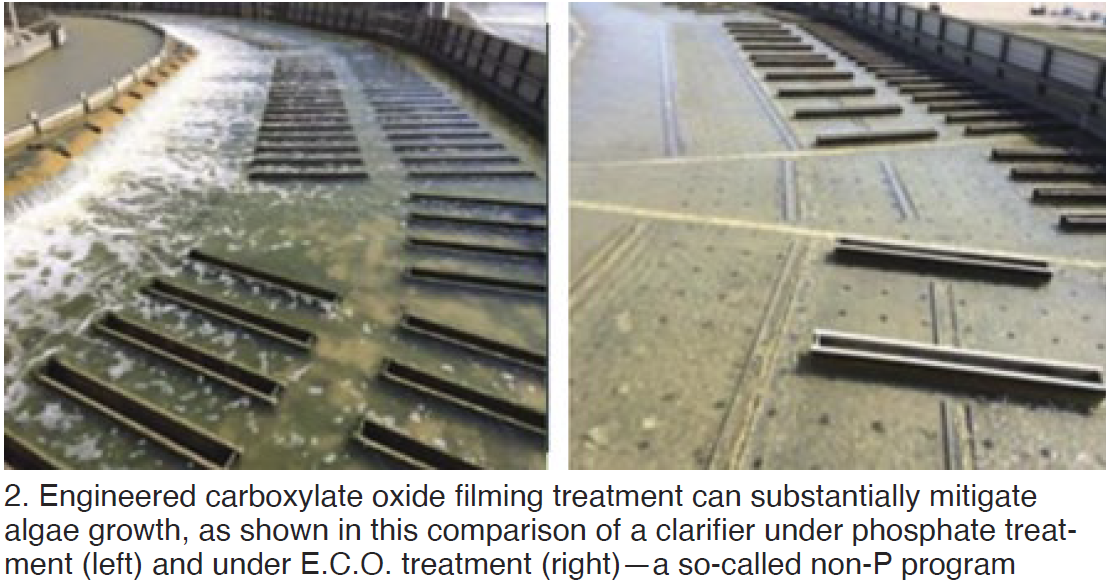
Boileau reviewed the key drivers for reducing phosphates, sources of phosphates in the plant water balance, and several case studies. Much of the return on investment comes from avoiding the capital cost of a phosphorus removal system. Other Suez information online suggests the proprietary technology reduced phosphates by up to 80% in the pilot study at a large gas-fired plant while maintaining acceptable mild-steel corrosion rates.
studies. Much of the return on investment comes from avoiding the capital cost of a phosphorus removal system. Other Suez information online suggests the proprietary technology reduced phosphates by up to 80% in the pilot study at a large gas-fired plant while maintaining acceptable mild-steel corrosion rates.

You’ll want to watch the video below from Bill Kitterman’s “Tube Repair Clinic: The Good, the Bad, and the Ugly,” even if just to see the pictures of the “uglier” and the “ugliest” tube-to-header welds (photos). In true photojournalism fashion, Kitterman, head of Bremco Inc, now part of SVI Industrial, described six different styles of such welds and the four methods for accessing leaking tubes, including the one fit for an action movie title, “cut your way in, weld your way out.”
Kitterman encouraged industry attendees of the HRSG Forum to “do more to determine the root causes of tube failures.” He also asked users in the audience to understand that, for repairs of creep-strength-enhanced ferritic tubes (such as P91), the downtime required to do quality work could be longer than they might expect. Welding is the fastest part of the procedure, he noted. Stress relief, code requirements (national, state, and local), official inspections, and insurance-company compliance factors take most of the time.
Example: “Bremco has modified its Alloy 91 weld procedure four times since initial qualification—for pre-heat and post-weld heat treatment and weld-wire requirements.” Proper wrapping to maintain the heat during heat-treat is critical.
Kitterman discussed Weld Method 6, a repair that avoids post-weld heat treatment (PWHT) but is only good for butt welds and on tubes with a wall thickness of less than 0.5 in. “This reduces downtime considerably since PWHT can take up to 14 hours,” he added. He also mentioned Supplement 8 for thicker pressure parts, which also avoids PWHT. It’s good for attemperator piping, although Kitterman conceded that Bremco isn’t yet comfortable with the procedure.
One attendee asked about tube plugging, but Kitterman cautioned that plugging a tube can change the flow patterns. It’s no longer being steam-cooled so the hotter gas can impinge on adjacent tubes, and failures could cascade. Another asked if Bremco undertakes turnkey scope; Kitterman answered yes, but prefers to add third-party specialist heat-treat and inspection companies to the team.
Other questions and responses addressed sonic leak detection methods—all captured in the video recording a couple of clicks away.
With pressure parts, so much depends on high-quality welds. Even if welding “isn’t your thing” at the plant you are responsible for, it’s worth watching this presentation to gain a cursory understanding of what’s involved.
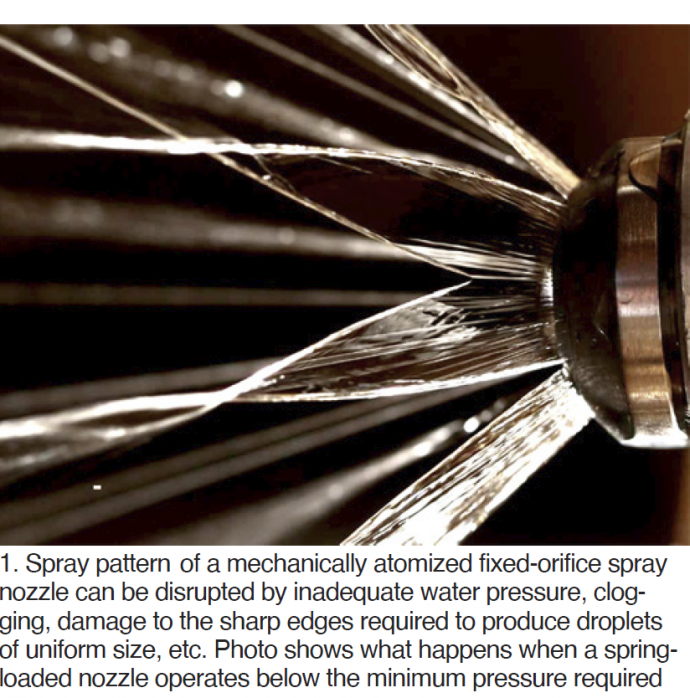
Since virtually everyone at a cycling plant faces issues with their attemperators (Fig 1), you’ll probably want to know about a unique design retrofitted to several Duke Energy combined cycles, one that uses the existing spray ring.
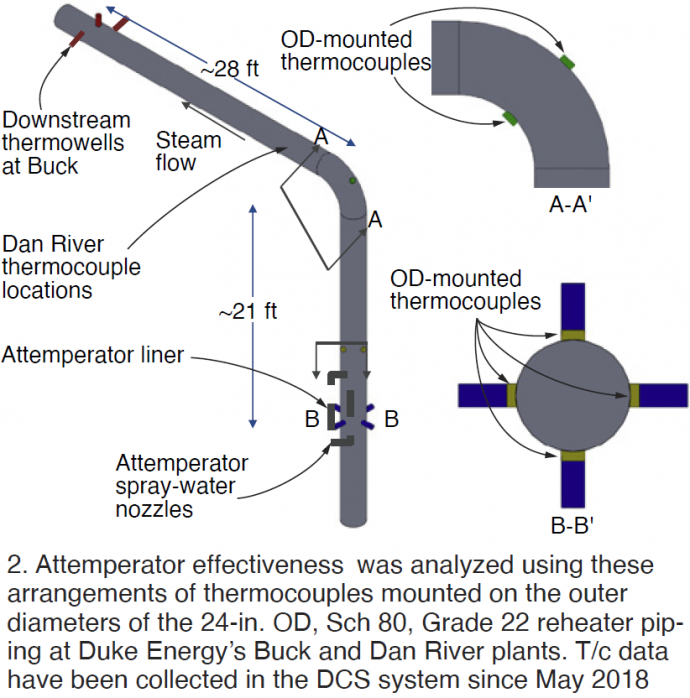 Key to the design is use of HP steam to provide the energy to atomize the spray water (Fig 2). This creates a much finer distribution of droplets, regardless of water flow, pressure drop, or steam velocity in the steam pipe, noted Justin Goodwin, director, Steam Conditioning Group, Emerson Automation Solutions.
Key to the design is use of HP steam to provide the energy to atomize the spray water (Fig 2). This creates a much finer distribution of droplets, regardless of water flow, pressure drop, or steam velocity in the steam pipe, noted Justin Goodwin, director, Steam Conditioning Group, Emerson Automation Solutions.
Steam-atomized nozzles are not new, but are considered unsuitable for high temperature applications like HRSG attemperators. Emerson reached out to corporate colleagues at Fisher™ to design new steam-atomized nozzles that fit into the existing radial-spray, spring-loaded nozzle ring. 3-D printing the nozzles (patented method) of a hardened cobalt chrome alloy (similar to Alloy 6) eliminated the many weld joints, and failure points inside the nozzles of a conventional steam-atomized unit.
“There are no droplets [of water] falling because they are so fine, which avoids the common attemperator failure mode of water impingement leading to damage on internal pipe surfaces. Plus, the design is highly resistant to plugging and corrosion,” Goodwin stressed. A tap at the h-p drum serves as the source of steam.
Note that the design is not applicable to the HP attemperator, only the reheater units. But good news for designers of new HRSGs: Smaller droplets can lead to a 30-40% reduction in piping lengths.
Lessons learned during the field trial are that a 1 in. to 2 in. connection in the atomizing steam supply piping was a choke point, as was use of a Y-pattern valve instead of a full-bore ball valve (a pressure transmitter was added to troubleshoot these issues). Modified control logic design is critical to a successful retrofit. In response to a question, the presenters noted that they replaced the water temperature control valve, but not the block valve.
Eugene Eagle, HRSG engineer, Duke Energy, and Goodwin’s co-author, said that Duke was pleased enough with the initial field trial on one unit at the utility’s Buck Combined Cycle Plant that they installed the new design at Dan River Generating Station on four additional units. The attemperator with the longest service life had 18 months of operating experience at around 85-90% capacity factor at the time of the presentation.
Duke has eliminated several failure modes, as well as the two-year inspection and test schedule for the previous spring-loaded nozzles, and is in the process of determining the cycle life for the new design. Current thinking is that the nozzles could warrant replacement every three years and that the internal piping liner should be borescope-inspected every two years. Thermal fatigue is the expected nozzle failure mode.
Many of the other questions addressed aspects of the control system (such as the operation of the block valve with the control valve), leakage at the block valve (you need a good block valve and trust it to be tight), the potential need for a second block valve, and possible issues with wet steam in the atomizing steam piping.
Presentations made by MD&A, Shell Lubricant Solutions, ARNOLD Group, and EthosEnergy Group to owner/operators participating in Weeks Three and Four of the virtual STUG2020 conference are summarized below. You can access the recordings and PowerPoints on the Power Users website.
 MD&A: Using turbine performance to improve your maintenance strategy
MD&A: Using turbine performance to improve your maintenance strategy
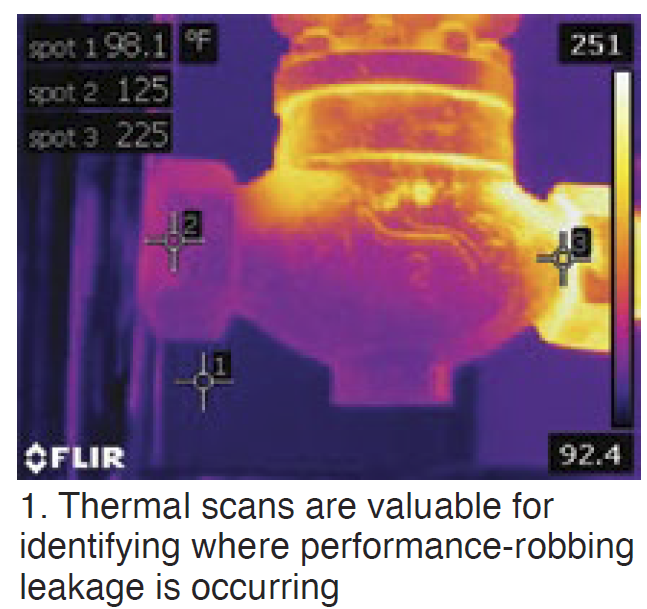 This presentation by James G Miller, PE, manager of performance services for MD&A, is a valuable primer for plant personnel participating in their first steam-turbine outage and equally valuable as a refresher for more experienced engineers and technicians. Miller’s message: Use the results of (1) recent performance tests conducted with the unit in service, and (2) steam-path audits made in the early stages of the outage, to reduce both outage cost and duration.
This presentation by James G Miller, PE, manager of performance services for MD&A, is a valuable primer for plant personnel participating in their first steam-turbine outage and equally valuable as a refresher for more experienced engineers and technicians. Miller’s message: Use the results of (1) recent performance tests conducted with the unit in service, and (2) steam-path audits made in the early stages of the outage, to reduce both outage cost and duration.
Miller reminded attendees that performance losses are a sign of degrading conditions that adversely impact the plant’s bottom line. The outage affords the opportunity to use this information for pursuing repairs and upgrades of greatest economic value.
The speaker covered the basics of performance testing, and how to conduct the all-important steam-path audit, in his presentation, which is available on the Power Users website complete with formulas, calculation examples, a comparison of as-tested performance to reference data, etc.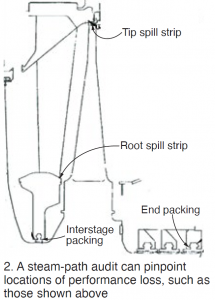
Best practices in performance testing—such a making sure there’s at least 25 deg F of superheat when calculating turbine efficiency—are included in the PowerPoint, together with a list of diagnostic parameters or additional tests that can be used to further characterize the sources of loss—such as solid particle erosion (SPE), casing leakage, and valve leakage. Thermal scans are particularly valuable for identifying the locations of leakage (Fig 1).
Examples of typical sources of performance loss identified during the steam-path audit include the following:
-
- Seal leakage (Fig 2).
- Surface roughness.
- Change in trailing-edge blade profile.
- Deposits.
Case studies identifying the reasons for performance loss in a reheat turbine at a combined-cycle plant, in a reheat turbine for a conventional steam plant, and in an industrial double-extraction condensing turbine are highly informative. For the first unit, performance testing revealed gross output had decreased by 2.3%. Excessive surface roughness, worn end packing, rubbed tip spill strips, and leakage by startup vents and HRSG drains were among the primary contributors to the loss.
A checklist of information to review in overhaul planning concluded the presentation.
Shell Lubricants: Choosing your lubricant not a one-size-fits-all
Lubricant selection is one of those subjects you might not think about for years, but when necessary it’s good to have a backgrounder like this at your fingertips—or only a couple of mouse clicks away on the Power Users website.
Key discussion topics include these:
-
- Base-stock evolution (Groups I through V).
- Varnish.
- Mitigation methods for varnish—including top-off fluids, filtration units, and fluid solutions (polyalkylene glycol, gas to liquid—lubricants made from natural gas).
- Field experience.
Varnish elimination with polyalkylene glycol (PAG) was a focal point of the Shell Lubricant Solutions presentation, which included a review of experience since 2001 at two units that switched to PAG to eliminate servo valve issues caused by varnish. Since then there have been no servo failures or trips while on PAG.
Recall that the stress experienced by a turbine lubricant contributes significantly to the ageing of petroleum oil, causing the non-polar fluid to oxidize. However, the resulting byproducts of decomposition are polar and insoluble in the base oil; they come out of the solution as varnish. Polyalkylene glycol, by contrast, is a polar fluid and, while it too oxidizes, the byproducts of decomposition are polar and infinitely soluble in the base stock. No varnish is produced.
ARNOLD Group: Advanced steam-turbine warming for increased startup flexibility
Pierre Ansmann opened his presentation on “the most advanced turbine insulation combined with a high-performance heating system to improve startup flexibility,” by summarizing its value proposition thusly:
-
- Increased in-market availability.
- Lower startup costs.
- Reduced thermal fatigue and longer mean time to repair for critical components.
- Increased operating flexibility.
He reviewed alternative warming-system arrangements, rejecting those integrating the heating circuits in insulation blankets, installing the heater on a thin mattress below the blanket, and using glass-fiber-insulated heating cable. The optimal system for the upper casing, they said, is heater on metal mesh baffle, for the lower casing, permanent mounting of heating cable below the split line.
The ARNOLD system features interlocking high-performance blankets which conform perfectly to the turbine surface (Fig 3). High-quality materials and manufacturing, and long-term high-temperature resistance, allow the company to guarantee reuse of its insulation system for 15 outages without a decrease in efficiency.
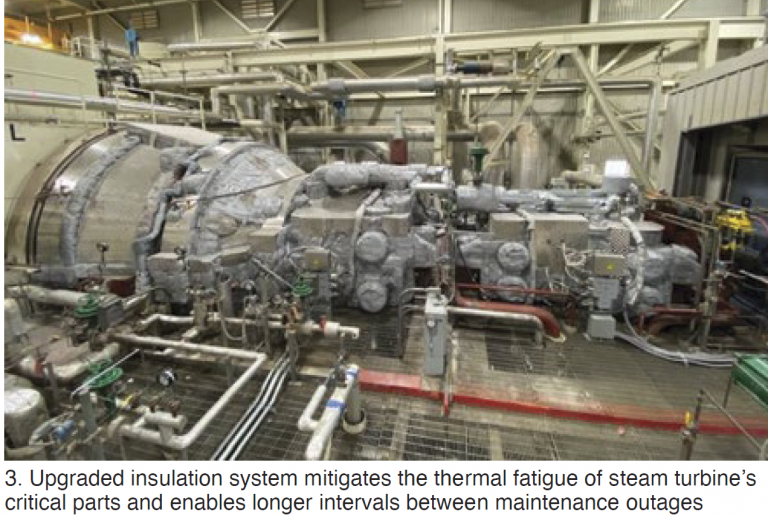
Dozens of thermocouples, strategically located on the turbine, ensure proper heating. Each of the 18 or so heating zones has t/cs installed on the heating wires to double check if the zone is responding correctly and at the specified temperature. Below every heating zone, multiple t/cs are mounted on the casing to confirm even heating of the turbine.
Ansmann said a properly maintained ARNOLD insulation system can maintain your turbine in a hot-start condition for at least four or five days after shutdown. No preheating of the turbine is required prior to a start within this time period, reducing startup fuel consumption and auxiliary power.
Combining high-quality insulation and warming systems enables tight control of casing-to-casing and rotor-to-casing expansion during shutdowns. A goal for operations personnel to aim for, Ansmann said, is a homogeneous cooldown to maintain the temperature difference between the upper and lower casings to less than about 100 deg F. Access the recording and slides here.
EthosEnergy Group: Multiple upgrades improve D11 reliability
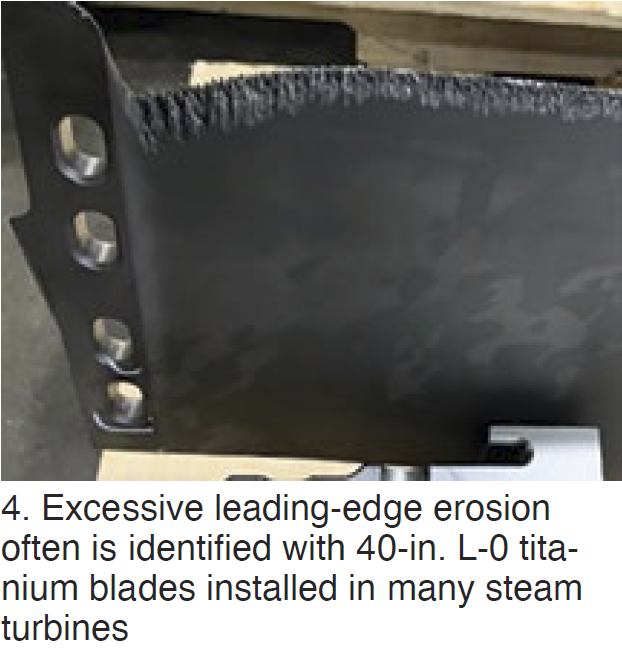 Owner/operators of the popular D11 steam turbine are sure to benefit from a review of this illustration-rich, 50+ slide presentation, easy to access the recording and hard copy in the Power Users archives. The presenters from EthosEnergy cover the repair of 40-in. L-0 blades, and upgrades of Smart seals and the N2 packing box, among other things. The subject plant was a 4 × 2, 1240-MW combined cycle. COD for the unit upgraded was 2011; first major inspection in 2020.
Owner/operators of the popular D11 steam turbine are sure to benefit from a review of this illustration-rich, 50+ slide presentation, easy to access the recording and hard copy in the Power Users archives. The presenters from EthosEnergy cover the repair of 40-in. L-0 blades, and upgrades of Smart seals and the N2 packing box, among other things. The subject plant was a 4 × 2, 1240-MW combined cycle. COD for the unit upgraded was 2011; first major inspection in 2020.
Two rows of the damage-prone L-0 blades were weld-repaired prior to the outage to correct excessive leading-edge erosion (Fig 4). Cracking in the blade pin-finger dovetail roots also was addressed. Presentation provides details likely of value to anyone facing the same issues. Photos illustrate key steps in the process, including re-blading of the L-0 row.
The Smart seal upgrade was done to address rotor vibration caused by seal rubs. Experienced users know the HP/IP rotor is very flexible and sensitive to mid-span rubs. Detailed measurements of packing and tip-seal wear (average horizontal, top, and bottom) are presented. Heaviest rubs are identified with the lower-half horizontal joint. The speaker noted that although clearances generally are larger on the bottom, wear is substantial at all locations.
A seal developed to upgrade OEM seals to avoid rubs and wear during startup and shutdown, by way of additional clearance, is illustrated. Reduced vibration during startup is one benefit. Another is increased revenue, said to be upwards of $17-million for a typical 300-MW steamer over an eight-year run time. Information on estimated savings in fuel and carbon emissions also are presented.
N2 packing heads, which contain shaft seals between the HP and IP steam paths, have a history of horizontal joint leakage. This impacts performance because HP inlet steam leaks into the IP section. Plus, steam cutting occurs across the horizontal joint. The presenter highlights what his company’s experts say are design issues that prevent maintaining a closed joint. Described modifications are said to mitigate the problem.
If you have never attended a STUG event, the summaries of user presentations from Week Three and Four of the 2020 virtual meeting in this issue of CCJ ONsite will encourage your participation in future in-person, live events. The information shared at these forums, vital to your professional development and your plant’s success, is available only through Power Users.
Registered owner/operators also can access the user experiences and presentations made by third-party products/services providers during Week One of STUG2020 (November 11) on the Power Users website. For technical presentations made by the OEM during Week Two (November 18), visit GE’s MyDashboard website.
User presentations
Alstom MI with IP blade replacement and L-0 replacement
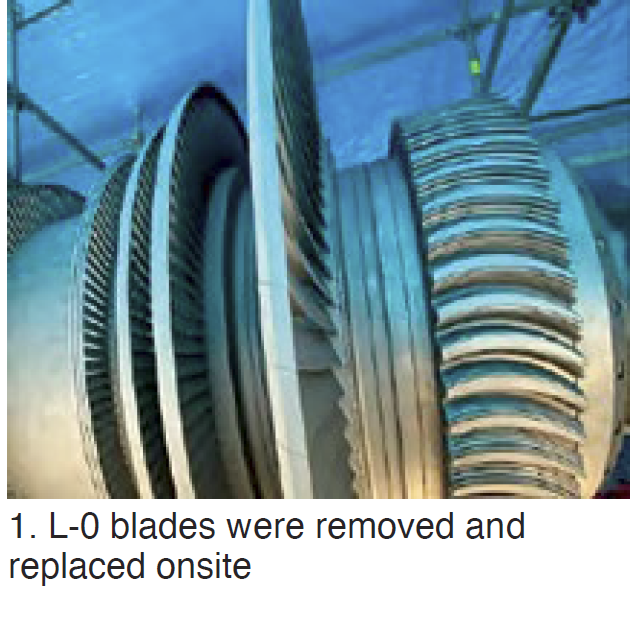 Reviews the planning and execution challenges associated with a recent steam-turbine major inspection, incorporating lessons learned. Background: The 282-MW Alstom steam turbine serving a 2 × 1 F-class combined cycle began commercial operation in 2003 and had a service history spanning 100k operating hours and nearly 600 starts. HP and IP steam conditions were 1050F/1975 psig and 1050F/483 psig, respectively.
Reviews the planning and execution challenges associated with a recent steam-turbine major inspection, incorporating lessons learned. Background: The 282-MW Alstom steam turbine serving a 2 × 1 F-class combined cycle began commercial operation in 2003 and had a service history spanning 100k operating hours and nearly 600 starts. HP and IP steam conditions were 1050F/1975 psig and 1050F/483 psig, respectively.
Scope of work for the full-train (HP/IP/LP/Gen) major inspection included the following:
-
- Inspect HP turbine stop/control valve inspections, replace Radax blade row, and provide new rotor and casing seals.
- Inspect IP turbine intercept stop/control valves, replace Radax blade row and first- and second-stage rotating blades, install new rotor and casing seals.
- Replace LP turbine L-0 blades and refurbish LP gland housing.
Speaker shares with colleagues IP rotor findings and the two blading replacement options considered: restore to original design or leave as is. For the LP section, L-0 blades were removed and replaced onsite with mix-tuned blades (Fig 1); no balancing was performed. Unit was returned to service with no vibration or operational issues.
GE D11 casing cracks and repairs (2013-2020)
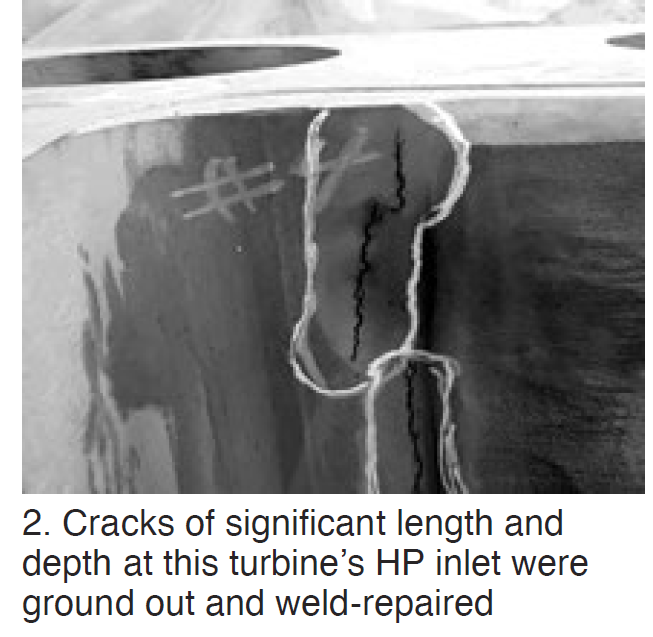 This presentation affords the opportunity to learn about the casing cracks and repairs made to a D11 steam turbine over the unit’s life from COD in 2002 through its second major in 2020. The first major, conducted in 2013 after nearly 45,000 operating hours and nearly 1700 starts, was planned for 49 days but took 95. Operating hours at the start of the second major numbered about 98,000, but there were only about 120 starts in the second interval.
This presentation affords the opportunity to learn about the casing cracks and repairs made to a D11 steam turbine over the unit’s life from COD in 2002 through its second major in 2020. The first major, conducted in 2013 after nearly 45,000 operating hours and nearly 1700 starts, was planned for 49 days but took 95. Operating hours at the start of the second major numbered about 98,000, but there were only about 120 starts in the second interval.
Inspection of the HP casing at the first major revealed cracks of significant length and depth in the inlet area (Fig 2). GE’s recommended welding procedure was reviewed by owner and plant personnel. It included a post-weld heat treatment of about 1200F for the entire HP/IP casing. However, during this process the casing was humped, requiring another repair. It involved removing about 200 mils of material from the horizontal joint in the HP inlet area to correct the distortion (Fig 3). Plus, machining of the diaphragm fits/steam seal faces and casing reliefs with a boring bar.
With the turbine gods smiling, the unit was reassembled and restarted with no vibration issues or rubs in January 2014. No issues were in evidence prior to the second major. But staff was apprehensive as the unit was opened for inspection. One crack was found on both the upper and lower halves that required attention. It was ground out and weld-repaired.
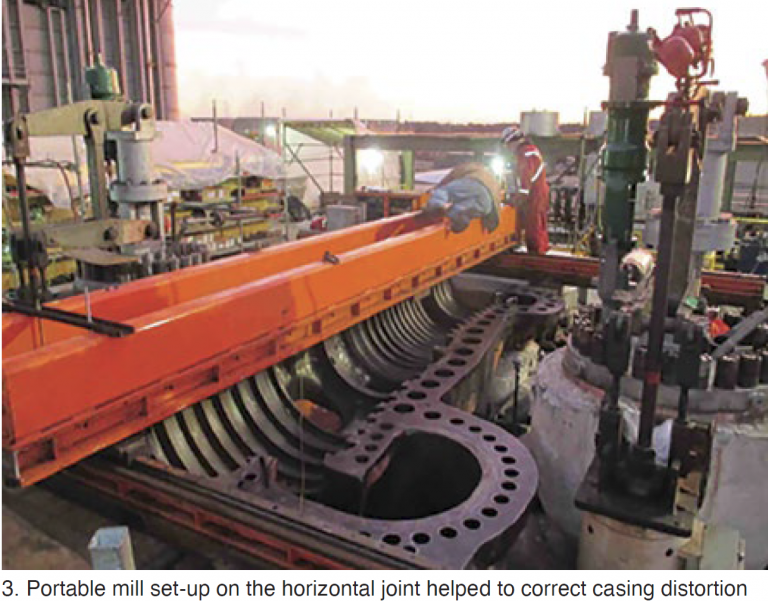
Creep and diaphragm dishing were in evidence and the experts conducting the investigation said they expected a casing replacement might be required at the next major. In sum, personnel believe that heavy cyclic duty prior to the first major contributed to the severe cracking corrected in 2013. Baseload service in the second interval mitigated the underlying issue. But the lingering question was the following: At what point does the plant quit trying to repair and evaluate retrofit options?
GE rotor indication recovery
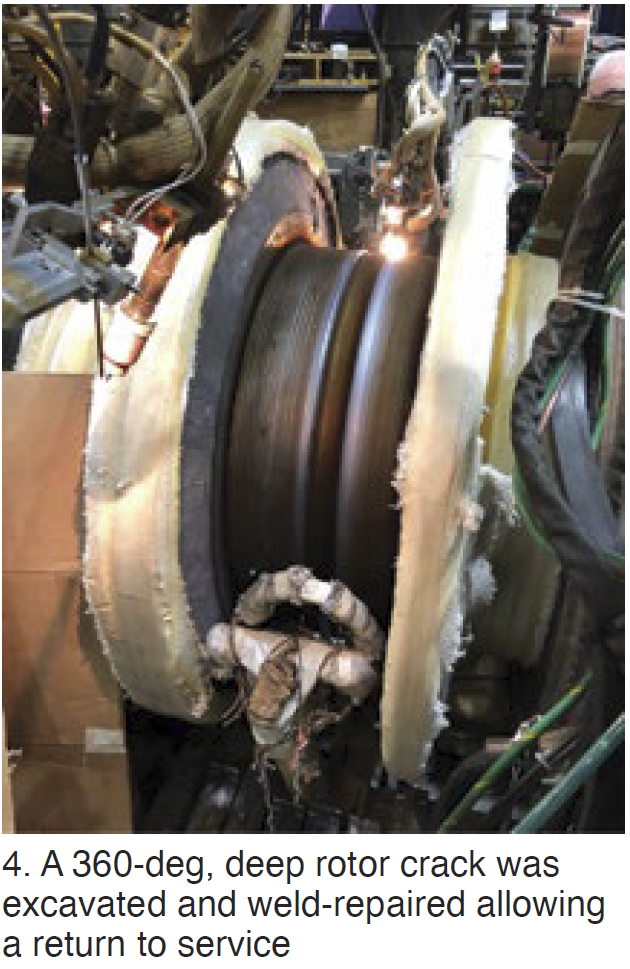 This analysis and repair of the rotor for a 523-MW GE G2 turbine is based on experience gained at the gas-fired steam plant since COD in 1973. Steam conditions for the unit, designed for baseload operation: 2270 psig/950F/950F. The first clue something was amiss was vibration identified in 2019—especially on the T1 and T2 IP bearings on coast down.
This analysis and repair of the rotor for a 523-MW GE G2 turbine is based on experience gained at the gas-fired steam plant since COD in 1973. Steam conditions for the unit, designed for baseload operation: 2270 psig/950F/950F. The first clue something was amiss was vibration identified in 2019—especially on the T1 and T2 IP bearings on coast down.
The unit was operated in the partial-arc mode and vibration occurred at certain valve settings. Going to full-arc admission eliminated the vibration. The unit tripped on high vibration in summer 2019. Upon disassembly, a 360-deg circumferential crack was found on the discharge side of the first-stage wheel transition area.
The rotor was shipped to the shop for additional inspection and evaluation. Cracking was found in other areas as well. Excavation of the first-stage crack was initiated, experts believing it to be at least 3 in. deep; it was 8 in. (Fig 4). Some details of the effort are shared in the presentation.
Outage duration was approximately 230 days. Since returning to service for the summer 2020 run, the unit has behaved well. However, the extensive weld repair reduced the rotor’s remaining life. A new like-kind rotor, in manufacture, is planned for installation early in 2022.
Post mortem: A review of vibration data from 2010 revealed clues regarding rotor cracking. The unit had operated for years outside the service parameters for which it was designed. The fast-start/fast-ramp paradigm adopted, with 500-deg-F thermal ramps and a dispatchable load range of from 50 to 500 MW, took a toll. The replacement rotor in manufacture has design enhancements to better accommodate today’s challenging operation requirements.
Maintenance of D11 stop valves and lessons learned
Fleet-wide perspective on valve maintenance based on operating-hour intervals and managed by the utility’s program called Optim. Findings focused on are solid-particle erosion of valve stems (Fig 5) and seat erosion. Shearing of main stop/control valve strainer anti-rotation pin, LVDT nut looseness, and implementation of GE’s “Digital Valve” upgrade (Fig 6) were other discussion points—all well illustrated.
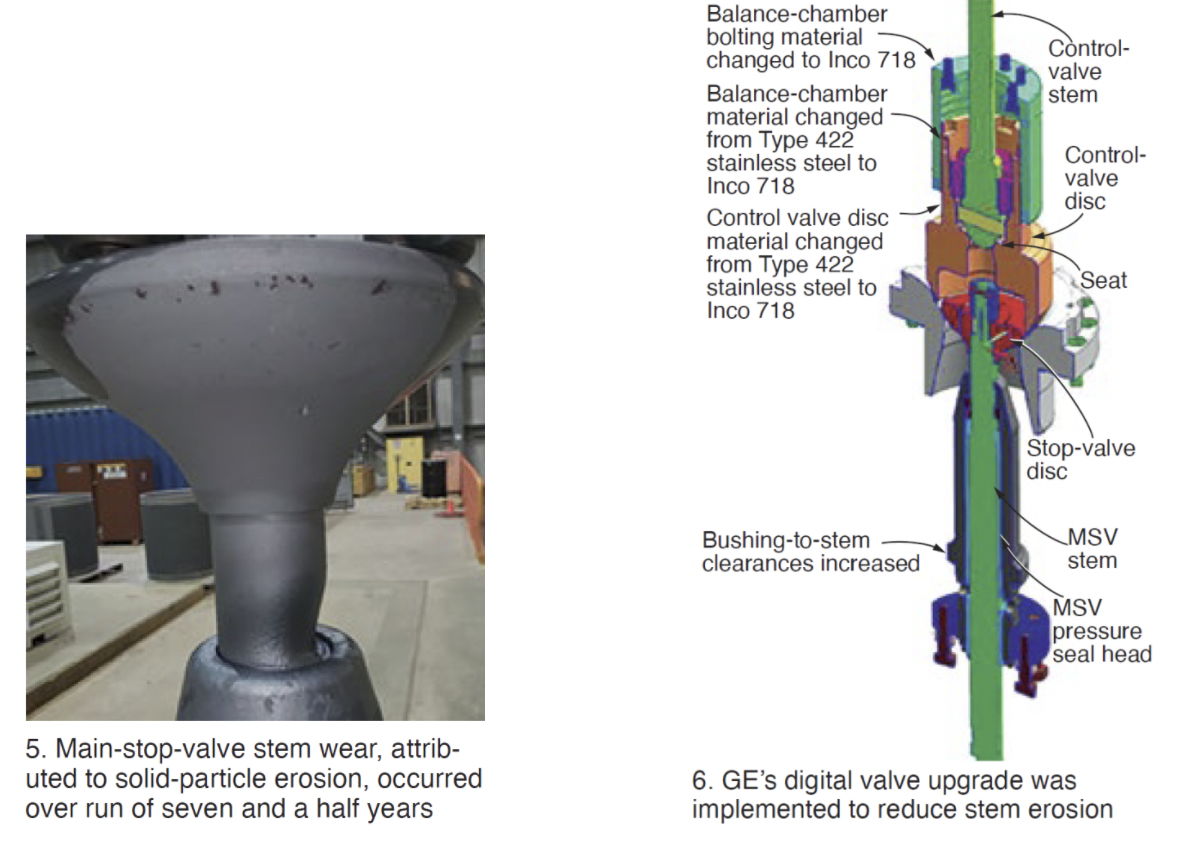
Three of the steam turbines addressed in the presentation rely on 32k operating-hour intervals for maintenance of their main stop/control, reheat stop/intercept, and LP admission stop/control valves. Another unit’s maintenance is based on 24k because it has experienced excessive scale buildup on the main and reheat valves. Findings and lessons learned are summarized in the slide deck available to registered users on the Power Users website.
Upgrading D11 valves
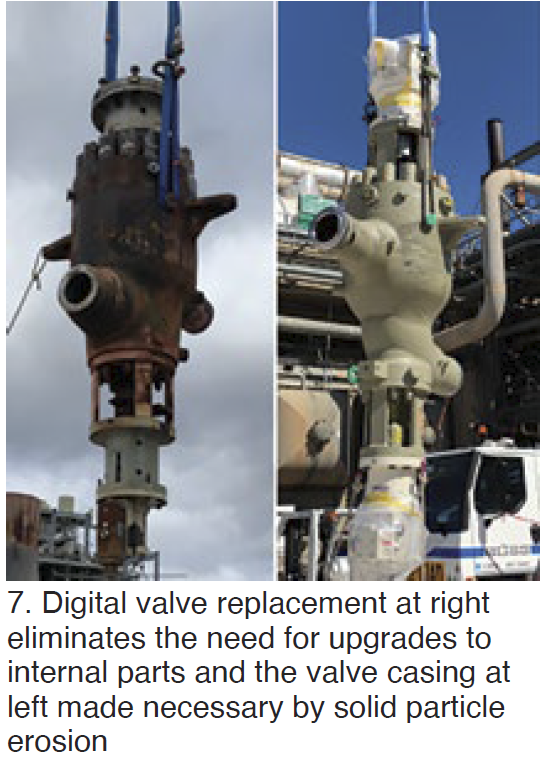 Presentation highlights valve findings and repairs, presents a historical perspective on valve indications, offers the owner’s perceived value of the OEM’s “Digital Valve” over in-kind replacements of damaged valves, identifies valve-replacement risks, how to plan for valve replacement, and operating experience to date with the digital valve.
Presentation highlights valve findings and repairs, presents a historical perspective on valve indications, offers the owner’s perceived value of the OEM’s “Digital Valve” over in-kind replacements of damaged valves, identifies valve-replacement risks, how to plan for valve replacement, and operating experience to date with the digital valve.
Lessons learned in the transition to GE’s digital valve (Fig 7):
-
- Obtain drawings early to resolve any discrepancies prior to the outage.
- Ensure all parts and components associated with the new valve are onsite prior to the outage.
- Order spare-parts kit along with the valve to assure availability of critical spares.
- Ensure all specialty tooling for shell-arm load checks are available with spare parts.
- Plan for new junction boxes and cable pulls to support below-seat drain relocations.
- Contractor hired for electrohydraulic line mods must be trained on how to bend stainless-steel tubing.
- Verify hardware on new valves is torqued and locking tabs are in place.
Benefits of the digital-valve package include daily online testing, ability to monitor performance, and the promise of extended maintenance intervals. Operations personnel verified the digital valves operate quietly and smoothly.
Valve O&M considerations for steam turbines and auxiliaries
Eric Prescott, EPRI’s program manager for valves, discussed maintenance strategies for valves—including condition-, fleet-, value-, and time-based programs. His slides on maintenance workflow, system maintenance approaches, and valve condition monitoring are excellent primers for personnel new to your O&M team.
Prescott digs into the details of valve damages and operational stressors. For example, on the all-important subject of solid-particle erosion he examines the sources of particles, plus the importance of particle incident angle, steam velocity, and erosion-resistant materials for minimizing damage.
Coverage also includes fasteners and sealing elements, the spindle-guide bushing interface, Stellite hardfacing, monitoring of valve castings for service fitness.
STUG steering committee for 2021
Chairman: Seth Story, Luminant
Eddie Argo, Southern Company
Jess Bills, Salt River Project
Jake English, Duke Energy
Jay Hoffman, Tenaska
John McQuerry, Calpine
Matt Radcliff, Dominion
Lonny Simon, OxyChem
Founding members of STUG who recently retired from the committee are Bert Norfleet (2019) and Gary Crisp (2020)
It’s not often you get something for nothing, or in this case almost nothing. Pay for an expert review by a couple of top global gas-turbine consultants with man-decades of experience, have them tweak your controls, and you likely can squeeze out a few megawatts and/or efficiency gains from an older gas turbine. No capital costs involved.
According to Bob Johnston, president, Keck Group International, speaking at the 2021 MENA Combined Cycle Conference (virtual), May 25-27, the key is an integrated, system-wide evaluation of the components currently in your machine (Table 1). “Some replacement hot-gas-path (HGP) parts are actually upgraded parts which supersede their earlier versions, and could qualify for higher firing temperature,” Johnston stressed.
This so-named “non-capital-parts uprate program” has been successfully applied to “many dozens” of GE machines and also can be applied to other OEM machines. Johnston explained that OEMs often supply upgraded parts as in-kind replacements but don’t tell the customer that they’ve replaced enough parts to qualify for an uprate. In fact, this is the “likely” situation for older machines, typically those shipped before 2001. For example, most of the later-vintage HGP parts for the MS5002 and MS700EA are directly interchangeable with all prior vintages.
Tweaks identified by Johnston which can arise from the parts evaluation are:
-
- Inlet guide vane (IGV) angle change.
- Isotherm setting increase for power at higher ambient temperature.
- Exhaust thermocouple (t/c) corrections.
- Degradation correction to control curve.
- Tilted control curve.
Exhaust t/cs were biased high on machines between 1980 and 1997, and a straight-forward controls setting change can net up to an 11-deg-F increase in turbine exhaust temperature. Results for 11 gas turbines in the Middle East (Table 2) show that not all the tweaks apply to every unit (Table 3). Output gains ranged from 2.4% to 10% for three separate groups of 56 engines without applying IGV angle-change tweaks.
Standard GE control curves maintain constant firing temperature at all ambient temperatures. A tilted control curve overfires the machine by 16 deg F on hot days, and underfires the machine by 25 deg F on cold days. This can give a 1.6% output boost on hot days, with no net impact on parts life or maintenance cycles. Again, only control setting changes are necessary. Most sites value an output boost during peak summer periods, and can sacrifice small decreases during cooler periods.
Control curves are based on a new machine, but as operating hours mount, non-recoverable performance degradation occurs, which reduces output, but also leads to under-firing the machine because the control curve hasn’t been adjusted. “By applying a suitable correction to the control curve, you can gain 0.8% output,” notes Johnston. This has been done for “hundreds of machines since the 1990s,” he added.
Users are cautioned that the higher turbine exhaust temperatures which lead to the output gains could raise the HRSG’s HP superheater temperature beyond its limit (figure). Two ideas here are to add desuperheater capacity or remove fins from the superheater tubes. Careful analysis could reveal other options as well.
Twenty years ago, few people probably thought that a tube cleaning technique for HRSGs attached to gas-fired turbines would be adapted from those used for solid-fuel boilers. Yet that’s where we are today. Carl Wise, Thompson Industrial Services, and Vince Barreto, PowerPlus Cleaning Systems, showed attendees at the HRSG Forum Supplier Workshop, Oct 7, 2021, that such a system can be elegantly designed and operated even if it’s dislodging and removing tons of material stuck on HRSG tubes.
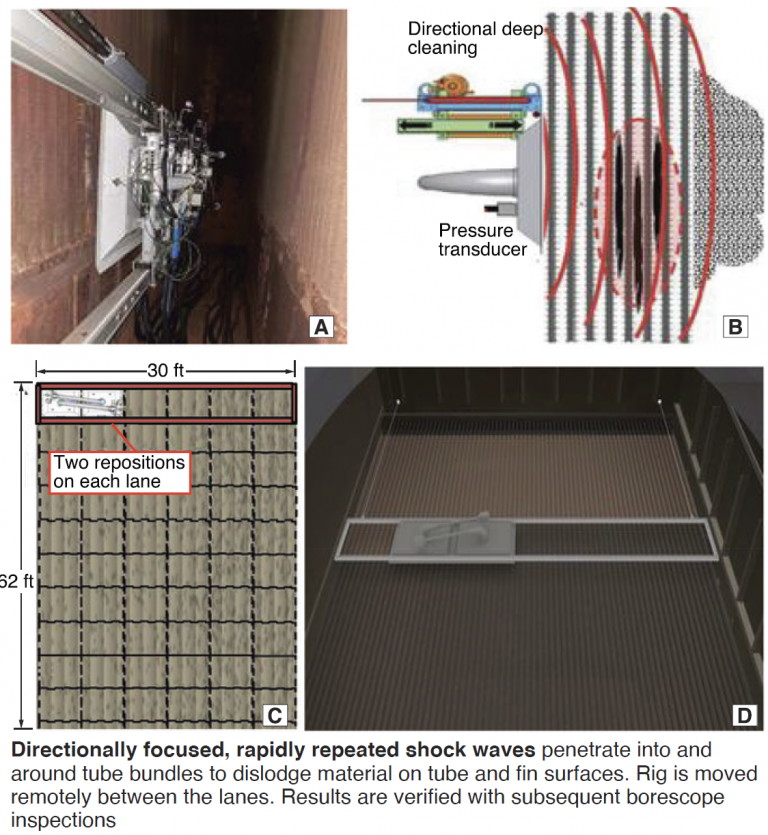
The technology, originally called PowerWave+ when introduced by GE in 2006 as an online system for solid-fuel boilers, was converted from a sound-wave- to a shock-wave-based process, then acquired by PowerPlus in 2014 and adapted to offline cleaning. Simply, the acoustic driver attached to a sound horn, was replaced with a combustion tube to create a pulsed detonation cleaning device.
PowerPlus calls it Extraction Pressure Impulse Cleaning (EPIC). While the recording of the Forum presentation gives more details about the technology, what you really want to experience are the videos, which show how the device is engineered into a “navigation rig,” temporarily installed in the lanes between the tube bundles, and moved remotely from location to location while a technician monitors the cleaning on a 50-in. screen.
The rig is arranged for the HRSG being cleaned, which can be vertical or horizontal, and can accommodate baffles, which one astute attendee asked about. If sky-climber ports are not available for rig support, they must be added, although Barreto noted he’s only encountered one unit that was not so equipped. Another attendee wondered if the blasts would dislodge material on the ID side of the tube and the answer was “no”; the shock wave energy does not reflect through the tube wall.
Two of the key benefits of this technique over dry-ice blasting and open detonation, say Barreto and Wise, are avoiding scaffolding or sky-climbers and providing the capability to deep clean “every square foot of the heat-transfer surface.” Tube sections are subjected to the shock waves from the lanes on both the upstream and downstream sides.
Several case studies were presented with dramatic total tonnages of material removed, several inches of differential pressure restored, and 1-2 MW of output recovered.
Unlike many user-group events, the 2021 Combined Cycle Conference for the Middle East/North Africa (MENA) region began with a primer on combined-cycle facility design, which set the stage for detailed presentations on gas-turbine, steam-cycle, and balance-of-plant upkeep, repair, and upgrade techniques and technologies. Perhaps the only major subsystem omitted was steam/water treatment for maintaining proper cycle chemistry.
Sponsors of the virtual meeting were GE, Allied Power Group, ARNOLD Group, CoreTech Industrial Corp, EMW filtertechnik GmbH, John Cockerill, Keck Group International, MD&A, and SPG Dry Cooling.
Joel Holt, operations manager at CoreTech’s Plant Systems Div, kicked off the conference with a presentation on combined-cycle plant basics. The editors consider this must viewing for folks new to the industry and a worthwhile refresher for veterans.
As one example, Holt compared a 2005-vintage combined cycle to a 2020 facility, and the contrast is stark if you haven’t thought about it for a while: A two-hour hot start versus less than 30 minutes today, around 50% efficient versus 62+%; steam turbines and HRSGs designed specifically for combined cycles (rather than designs lifted from other applications), and features like purge credit and system simulation not even available 15 years ago.
HRSG. Raphael Stevens, John Cockerill (formerly CMI), began with a review of his firm’s 200 years of industrial experience and an install base of 800 horizontal, vertical, and once-through HRSGs (amounting to 120 GW and 10% of the world HRSG market, he claimed).
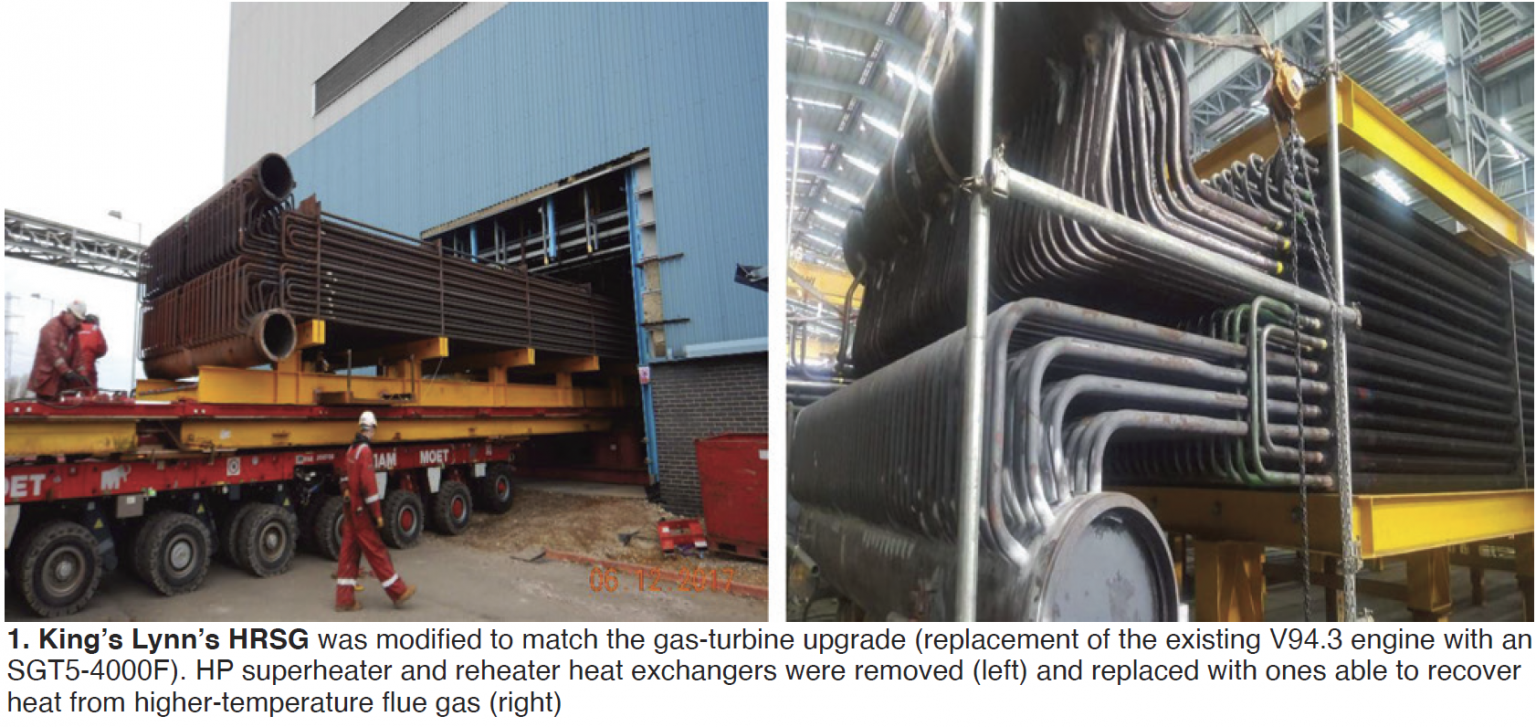
Stevens gave examples of recent projects, including HRSG modifications to match the boost in output from a GT upgrade at Kings Lynn Power Station in the UK (Fig 1), and for one of the world’s largest desalination plants, a new low-pressure module added between the HRSG and stack (Fig 2) reduced stack temperature from 352F to 273F, thereby increasing water production and decreasing CO2 emissions.
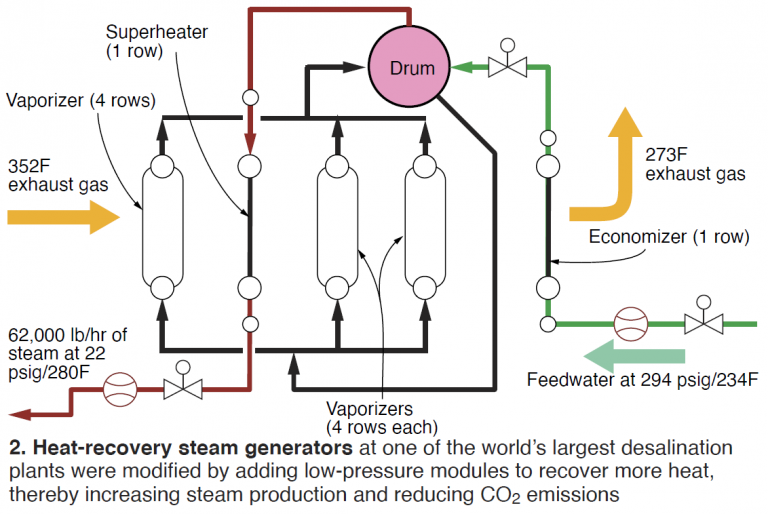
Performance enhancements. Bob Johnston, Keck Group International (KGI, formerly GE Gas Turbine Upgrades), opened by saying “GTs may be ‘forever’ but customer needs change.” KGI’s services include engineering support to evaluate performance enhancements—including lifecycle evaluations, faster startups, efficiency improvements, controls upgrades, emissions support, and upgraded parts evaluation.
Johnston’s presentation is replete with nuggets of insight. For example, he stated that exhaust thermocouples on GE units were biased high between 1980 and 1997 and can be corrected to improve performance. And some replacement hot-gas-path (HGP) parts are actually upgraded (superseded) components which can qualify for higher firing temperatures.
He also discussed a “tilted control curve” which can allow you to overfire on hot days to boost output, and underfire on cold days. Normally, the GE control curve maintains constant firing temperature for all ambient conditions.
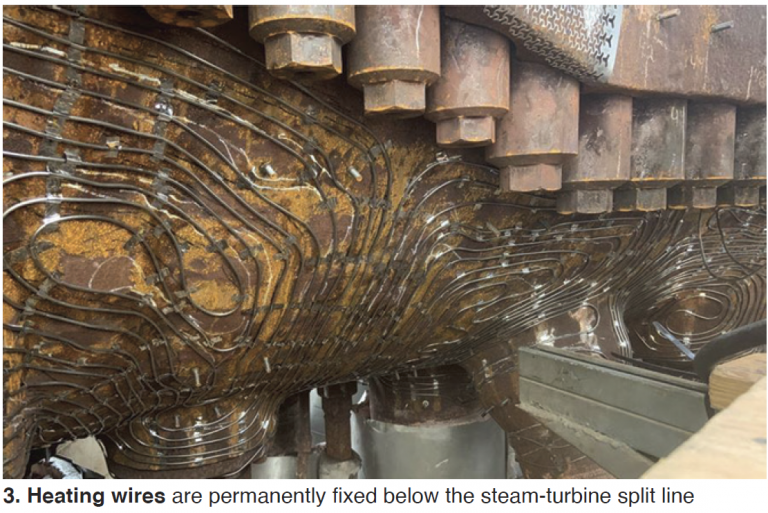
Steam turbine warming. Pierre Ansmann, global head of marketing for ARNOLD Group, presented on his firm’s advanced single-layer turbine warming system (Figs 3 and 4). This is must viewing if you’ve never thought that hard about steam-turbine insulation and their support and casing-attachment systems, differences between bottom and top insulation (25% thicker on the bottom, removable on the top side), casing heaters and attachments, and advanced controls which ensure every heating zone is controlled to within 1 deg C. Arnold guarantees that insulation surface temperatures do not exceed 15 deg C above ambient, and the unit is “hot-spot free.”
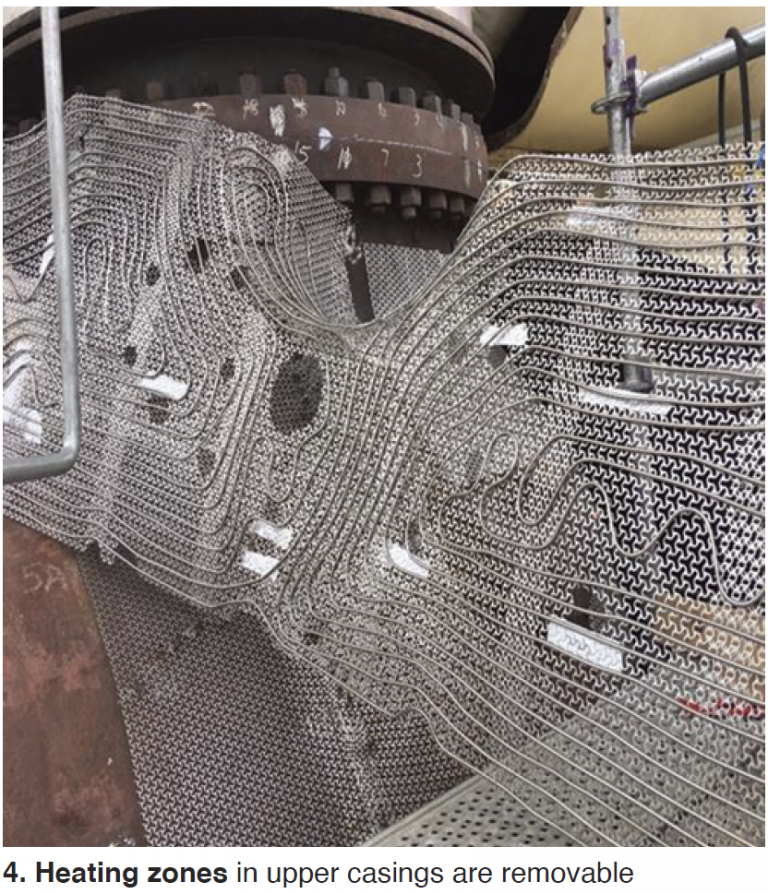
Dry cooling. Frederic Anthone, aftermarket manager, SPG Dry Cooling (a member of Paharpur Cooling Towers) opened with an overview of his firm’s 150,000 MW of air-cooled condenser (ACC) installations worldwide, and five basic designs—A-frame, Box Air, and Hexacool for plants less than 50 MW, and Module Air and W-style for large plants.
Because “performance always changes with plant cycling and ambient conditions,” Anthone dwelled on the need for regular testing (for example, vacuum leakage test), inspections (including drones) by specialists, and/or an ACC360 continuous monitoring and diagnostics (M&D) service program so cleaning and repairs can be properly planned, rather than forced.
“Data-driven analysis combined with thermal modeling can detect failures before they occur,” Anthone said, “which can increase reliability during adverse ambient conditions.” He offered brief case studies, one of an 800-MW plant that increased ACC thermal capacity to accept higher steam loads, in which all motors/gearboxes were replaced and upgraded without changing fan blade geometry.
GT repairs. Jason Brown, senior VP of business development, Allied Power Group, called his firm the “largest independent GT repair company in the world” as a result of “many acquisitions over the last few years.” He then noted the 3100 transition pieces sold for all GE frames through the 7FA.04, the 1900 combustion liners/CCP assemblies sold, and other components, some of which he said are better than the OEM’s for repairability. Repairs—including rotors—can be conducted on most GE and Siemens/Westinghouse machines.
Coatings are a “primary competitive advantage” of APG’s offerings, and are equivalent or superior to the OEM’s, he added. “We have 12 coating booths in operation and each of them can handle all necessary components.” The field services group can manage up to 10 outages at one time. One of the case studies presented involved the life extension of a crude-oil-fired GT, now expected to achieve a 12,000-hr inspection interval, whereas before the interval was far shorter.
GT filters. Andrew Thompson, project engineer, EMW Filtertechnik (family owned since 1954), reviewed the important standards his company can test to and meet—including EN779, ISO 16890, Ashrae 52.2, EN1822 (HEPA standard), and ISO 26463. Thompson underscored the importance of high-quality filters kept clean by showing photos of compressors after only 5000 hr of operation after online and offline cleaning. Spoiler alert: The photos aren’t pretty.
High-end filter media are also easier to clean, too. No compressor washing is necessary and the machines remain “completely clean” after 5000 hours. “Washing really only cleans the first-stage blades,” he said. Changing from an F8 type filter to an E11 or E12 can “dramatically increase performance and reduce outage work,” Thompson concluded.
Mechanical Dynamics & Analysis (MD&A, a Mitsubishi company) then delivered a series of presentations on gas and steam turbines, generators, turbine valves, and control and excitation systems. Jose Quinones covered GT component repair experience with 6FA, 7FA, 9FA, 7FA.03, and many other GE machines, totaling close to 1250 sets of F-class components.
Neil Jones spoke on steam-turbine inspections and repairs for what he termed “almost all OEM- manufactured equipment.” He included a case study from 2020 in which a bowed rotor was straightened from 16 mils to 4.
If you didn’t realize that an inspection and recommendations report for steam-turbine valves could run 60-120 pages, listen to Jason Wheeler’s presentation to find out why. One of Wheeler’s stats: 75% of overspeed events are caused by improper valve operation. Depending on the aggressiveness of service, these valves must be inspected every three to five years.
James Joyce covered generator stator and rotor repairs, and began with a primer on generator components. Much of his material addressed the question: “Should I re-wedge or not?” When the answer is “yes,” MD&A can handle in-kind wedging or upgrades, he said, “which can be beneficial but very labor intensive.” Several options and tradeoffs must be considered, which is why you may need to call in specialists. Re-wedging takes 8-10 days and does increase outage costs. Core tightness checks and frequency bump tests should be included the project.
Michael Broggi addressed dealing with obsolescence of, and adding selective upgrades to, generator controls and excitation systems. Modern systems can include high-speed data capture and storage for troubleshooting. “This goes beyond PI data because faults are often in the milliseconds range,” he stressed.
Through an acquisition, MD&A now offers the IBECS® “fully integrated” control platform in which all HMI is encrypted and the system is “set up to be cyber-secure, with native drives and open-source protocols and features such as advanced alarming, pattern recognition, time synchronization, sequence-of-events recording, high-speed trending, and remote access and monitoring.”
GE Day
The underlying messages from GE Day at the MENA Combined Cycle Power Plant Users Symposium was that, regardless of which region of the world you operate in, (1) mission and operating changes are coming to your plant, and (2) GE Gas Power specialists can help you analyze the impact of those changes on your equipment, recommend solutions, and implement them.
Jeff Chann, business intelligence leader, took the highest-altitude perspective and presented on the global industry transformation. The push to decarbonize a global economy essentially built on fossil fuels over a hundred year or more period will impact all gas-fired facilities.
As renewables grow, combined cycles not originally designed or built for cycling will have to be modified to do so. And unlike other regions, MENA’s electricity demand is still growing at a rapid pace. “One-billion people on this planet still need electricity,” Chann reminded his audience, and that need has to square with decarbonization.
John Sholes, principal engineer, then introduced Ahmed Gaber, application engineering leader, MEA Region (Middle East and Africa), who reviewed some of the mission outcomes that may be necessary as this transformation unfolds: higher peak load, more fuel flexibility, turndown to lower loads, faster starts, and higher cold-day or hot-day output.
Sholes noted that addressing the limitations on the balance of plant from a gas-turbine uprate will likely cost only a fraction of the GT uprate. He said GE specialists can analyze your plant’s performance and goals and recommend upgrade options. One example: If your attemperator valves are topping out, analyzing the operating data could reveal that relatively minor modifications can address this and eliminate water hammer during load transitions.
Akram Ismail, senior solution architect, and Mohamed Hamdy, lead customer application engineer, presented a case study for a 9F.03 combined cycle, where the gas turbines had been upgraded with the OEM’s Advanced Hot Gas Path, the steam turbine upgraded with GE’s Advanced SteamPath, and the HRSGs upgraded to improve overall plant performance.
Akram and Hamdy showed the evaluations used by GE to identify potential impacts on plant systems and discussed solutions to fix identified equipment limitations and scope offered for implementing concluded resolutions.
The following presentations then drilled down to the generators, HRSG, and steam turbine. They are available on the OEM’s MyDashboard website.
Generators. Karim Bakir, lead customer service engineer, EMEA Region (Europe/Middle East/Africa), reviewed generator maintenance practices and lifecycle issues, especially after the onset of cycling. Generally, he said, users need to consider a rewind for the rotor after 15 to 20 years, and for the stator after 25 to 30 years. However, cycling duty may accelerate those schedules.
Bimpe Olubode, lead customer service engineer, EMEA Region, reviewed new developments in collector rings and brush systems. Janusz Bialik, principal customer service engineer, EMEA Region, spoke about generator health monitoring and recommendations. Benjamin Kreyssig, lead customer service engineer, EMEA Region, presented a forced-outage case study on a 7FH2 generator field.
The speaker explained how the field defect (ground fault) was ascertained based on GE diagnostic experience and fleet know-how. Detailed review of the observed findings identified what caused the ground-fault event. Plus, the presentation highlighted how GE was able to provide the field owner the best service option, including a spare field, to minimize generator downtime.
The HRSG presentation, led by Vasileios Kalos and delivered by Mohamed Hamdy, lead customer application engineer and Salim Kassis, senior sales manager, reviewed the replacement of pressure parts to extend life and reduce O&M costs—with an emphasis on upgrading from carbon steel to Gr11 alloy. Details were also given on GE’s pressure wave plus technology to address HRSG tube fouling.
Recall that pressure wave is an offline cleaning technique which uses controlled acoustic shock waves, or “bangs,” to knock debris off the tubes. A total cleaning on an HRSG serving an F-class unit takes about four to six shifts. For every inch water column of backpressure increase, the plant typically loses 0.2 MW of output and 0.1% heat rate. GE recommends that tubes be cleaned when backpressure reaches 3-in. H2O above specification.
Steam turbines. Matt Foreman, combined-cycle steam-turbine fleet leader, and Salim Kassis, delivered observations and findings from the product service team on impacts when units shift to low load and cycling service. Sites need to understand what these impacts can be, monitor for them, and engage in long-term mitigation planning. A few examples cited:
-
- Erosion of valve components can increase when the valve is throttled to achieve lower loads.
- Highly loaded components, such as rotors and last-stage blades, will accumulate more LCF damage with an increase in annual starts.
- Leading-edge erosion of turbine blades is accelerated by low-load operation.
GE spoke to solutions that range from upgraded replacement components like NextGen Valves and Advanced SteamPath to basic repairs to mitigate impacts of low-load and cyclic operation, but monitoring, diagnostics, and planning are critical.
The last presentation reviewed how analyzing operating data can help diagnose and identify emerging steam-turbine issues, flag minor problems before they become big ones, and inform maintenance planning. For example, when tracking the difference between the upper and lower turbine-shell metal temperatures, a delta T trending high from shell top to bottom indicates a higher risk for rubs. This can be addressed by checking for quality of insulation and ensuring proper installation of insulation. Changes in transient vibration over the unit’s operating life may help diagnose rotor bowing, as another example.
Such changes can be very gradual over time but nevertheless meaningful for diagnostics. The speaker suggested that users lacking the necessary expertise consider subscribing to GE’s OSM monitoring service.
Doyle Unit 1 is a legacy GE 7B gas turbine with a 64-MVA/14.4-kV, 30-psig hydrogen-cooled generator. A thorough investigation of the engine by Oglethorpe Power Corp engineers revealed degradation of its asphalt insulation and estimated remaining life at less than two years. Several equipment condition and operational performance gaps with the hydrogen cooling system also were identified during unit inspection and testing. Bringing the cooling system up to industry standards would have required an investment of $400,000 to $500,000 (est), according to Fleet Manager Michelle Crane.
The plant’s goal was to find a safe alternative to hydrogen coolant for the predicted remaining life of the generator. Staff researched the practicability of using helium as the cooling medium in a hydrogen-cooled generator and in April 2018 the idea was tested and implemented on Unit 1.
A hydrogen-to-helium conversion was considered primarily because of condition issues with both the hydrogen cooling system and generator stator. Regarding the former, the original OEM control panel was 50 years old, the hydrogen scavenge system was in poor condition, there was no haz-gas detection for hydrogen and no emergency auto-purge functionality, etc.
Regarding the stator, a rewind was recommended because of its deteriorating condition, polarization index was less than 2 megohms, debris from the degrading asphalt insulation was accumulating at both ends of the stator, glass tape was unraveling on series loops at the collector end, stator end basket was in a weakened condition, etc.
Doyle 1 was tested successfully using helium as the cooling medium on Apr 13, 2018. For verification purposes the machine was operated from a minimum load of 52 to 60 MW while varying reactive power from +30 to -10 MVAr. Helium and field- and stator-winding temperatures were monitored and captured throughout the trial run, along with gas pressure.
Generator temperatures were 20-25-deg-F warmer with helium as the cooling medium than with hydrogen. But the average gas temperature of 166F was well within the Class B insulation maximum temperature requirement of 266F. Helium purity, monitored with in-place calibrated instrumentation, was maintained without need for scavenging; no windage loss was observed. Testing proved the unit could operate with sufficient cooling to the generator, and without operating limitations, while using helium.
During the 2018 summer season, the machine was dispatched 12 times for peaking purposes, operating 57.2 hours. As predicted, a generator fault caused by age and insulation deterioration did occur as the summer was winding down; however, an inspection found not connection between helium cooling and the failure. The bottom line: Testing and operation of Doyle 1 verified the viability of helium as a possible alternative to hydrogen for generator cooling.
Wireless camera keeps extra set of eyes on Mulberry Cogen’s equipment
In any fast-paced O&M environment, there are times when certain pieces of equipment require additional, temporary, periodic observation—such as valves, exposed tank levels, pumps and motors, or even areas of the plant grounds.
Generally, this function is performed by roving operators who must break away from their rounds to travel to the area requiring observation. This can be a challenge, especially if the item requiring enhanced monitoring is located on top of the HRSG or in some other hard-to-access location. Plus, this approach permits critical observation for only as long as the operator can remain at the scene.
Simple solution. Most sites now have comprehensive security-camera systems and a wireless camera for equipment monitoring can be plugged into one of its unused channels, says Plant Manager Allen Czerkiewicz. Mulberry’s wireless camera is moved to wherever needed, allowing the CRO a live look at the area of concern while he or she remains in the control room. The display is viewed like any other camera on the system.
An added benefit is that the camera also records, enabling staff to look back at any event that occurred. After the temporary monitoring assignment is completed, the camera is picked up and brought inside or moved to another location.
The camera has been used extensively since it was purchased, and has been improved by affixing a magnet to the camera base (photo) and by purchasing attachments that allow the it to be installed practically anywhere—from round railings to flat metal surfaces. The camera and receiver are powered from 110-Vac outlets, although a battery-powered inverter can be used in remote locations.
Platform facilitates borescope access, improves safety at Lincoln
The gas turbines installed at Lincoln Generating Facility were not equipped with platforms for accessing the power-turbine sections of the units (photo left). For example, reaching the borescope ports on the lower portion of the turbine required staff to place two planks across the open space as a temporary work platform.
Plant Manager Brad Keaton said that during monthly VPP safety committee meetings this maintenance practice was discussed and participants agreed a change was required. Site personnel developed a work scope and solicited quotes from qualified contractors to install OSHA-approved platforms (photo right).
The safer work area created allows disassembly, inspection, and reassembly of the turbine during borescope inspections. Temporary scaffolding during outages is no longer required. The project has a three-year return on investment.
The 7F Users Group and CCJ are working together to expand the sharing of best practices and lessons learned among owner/operators of large frame engines. One of the user organization’s objectives is to help members better operate and maintain their plants, and a proactive best practices program supports this goal.
Details of the 2020 entries judged Best of the Best were profiled late last year. Recall that the 7F-powered plants so recognized are the following: Hermiston Generating Plant, Green Country Energy, River Road Generating Plant, and St. Charles Energy Center.
Other 7F entries in the 2020 program receiving Best Practices Awards are summarized below (to dig deeper, consult CCJ No. 67). They speak to work done by your colleagues at 13 simple- and combined-cycle generating plants. The more than two-dozen best practices are likely to offer one or more ideas for improving safety and performance at your facility.
Barney Davis Energy Center
KPI index for water chemistry
Barney Davis Energy Center, Corpus Christi, Tex, implemented an EPRI-recommended water-chemistry KPI (key performance indicator) index. The plant’s original analyzers were updated and more instruments were installed, reported Plant Manager Jay Langley. Two dissolved-oxygen analyzers were added, plus one sodium analyzer; four silica analyzers were replaced.
All of the new analyzer readings were added to the DCS. KPI-index action alarms, Levels 1 and 2, also were added to the DCS in accordance with EPRI recommendations. An action plan was developed to guide operators when an alarm level is reached.
When conducting water-chemistry tests with manual grab samples, the number of samples and tests performed increased. Grab-sample data added plant-rounds documentation which is transferred to the data historian using a hand-held device. Next, the data are sent to an Excel file where the KPI scoring system is applied. It gives the plant an indication of where it needs to go regarding water chemistry. The score sheets are archived to allow quick reference to previous scores and to identify developing trends.
Replace haz-gas detector without compartment entry
Goal was to make replacement of turbine-compartment hazardous-gas detectors safer by eliminating the need for personnel entry into the compartment to perform this task. The
best practice shared facilitates detector replacement, which is done from the roof and can be performed in a few minutes—during an overnight shutdown, for example, without impacting unit availability. Following completion of site LOTO and safety procedures, the rail that contains the bad detector can be unbolted by removing four small bolts.
Change-out of a haz-gas detector went from 24 hours to 20 minutes. Cost of the procedure dropped by several thousand dollars because scaffolding is no longer required for access. Employee safety also improved because staff is not exposed to the high compartment temperature.
Bastrop Energy Center
Protect plant personnel, visitors with machine guards
Safety best practice: Install machine guards to protect operators and others against injuries caused by exposed rotating shafts. They are your first line of defense. Bastrop Energy Center, Cedar Creek, Tex, identified a potential hazard with its diesel- and motor-driven fire pumps. Plant Manager Kelly Fleetwood reported that the shafts on both sides of the pumps were exposed, creating a potential hazard.
Plant personnel fabricated the protective covers for the exposed areas. Expanded metal guards were used to allow visual inspection of the packing follower and to monitor bearing lubrication.
Calhoun Power Co
Safety enhancements
Objective of Plant Manager Mike Carter is to reinforce the safety culture at Calhoun Power Co, a 4 × 0 dual-fuel plant in Eastaboga, Ala, by making ongoing enhancements to plant systems that protect site personnel and visitors. Two safety enhancements recently implemented are these:
-
- Eliminate need for entry into a confined space to pump out the contents of a drain tank. The simple solution: Extend the tank’s drain line so staff can connect to the vacuum truck without entering the tank well.
- Eliminate need for a ladder by installing a permanent safety platform to reach over closed-cooling-water pipes to access the generator belly-pan level switch requiring a monthly test.
Central Eléctrica Pesquería (CEP)
Benefits of lean-outage planning, execution
Following this Mexican plant’s first hot-gas-path (HGP) outage in 2018, personnel, under the direction of Plant Manager Mario Ontiveros, met to discuss the pain points identified during the work just completed. Goal was to reduce the time needed to conduct scheduled outages and to optimize resources by ensuring the integrity of people and equipment. Savings would be near immediate because there were two more gas turbines at the 7FA.05-powered 3 × 1 combined cycle in the HGP queue.
Among the many pain points identified were these:
-
- Scaffolding installation.
- Removal of blades and nozzles.
- Lifting and dismantling of the package roof.
The methodology selected was “Lean,” which focuses on quality assurance, time reduction, resource optimization, and effective communication. The rigor applied to outage planning and execution was evident from the details provided in the best practice—including the following:
-
- A visual scaffolding installation plan was implemented and strategic scaffolds were assembled prior to turbine disassembly.
- The scaffolding plan allowed work in tandem in the disassembly of turbine elements and combustion chambers.
- A lifting plan was implemented to disassemble the entire roof, previously removed in sections. Plus, pre-location of mechanical lifting elements for easy availability.
Results: The execution time of the second and third HGPs was reduced by 15% compared to the first outage, which lasted 19 days. Quality standards were maintained and there were no problems during and after the outages. Finally, the OEM recognized CEP’s outage team as the best in Latin America based on the results of the second and third HGPs.
Optimizing the steam-turbine cooling process
Challenge: Develop a methodology to cool the steam turbine in the shortest time possible to conduct minor maintenance while adhering to the manufacturer’s cooling curves and delivering the output required to satisfy contractual obligations. Plant had determined previously that this could be accomplished by operating one of the three gas turbines baseload at 210 MW and the other two in temperature matching for nine to 12 hours.
Plant and OEM personnel determined that, in this case, dry-air cooling was the optimal method for rapid turbine cooldown. It did not adversely impact the cyclic life of the rotor or the critical path of the outage. The method consists of injecting a regulated amount of air gradually into the HP and IP stages of the turbine while assuring that the temperature differentials between the stages were not so great as to stress the rotor. Goal: Cool the unit to the point where the turning gear could be shut down.
About 30 hours of turbine operation were gained using this procedure in place of the previous (standard) method.
Redesign of sulfuric-acid dosing system eliminates leaks
Pesqueria’s sulfuric-acid dosing system for water treatment typically experienced three or four leaks per month totaling up to about 5 liters of acid—jeopardizing the integrity of personnel and equipment. A team was formed to address the root causes of the problem and correct them.
Steps taken included the following:
-
- Changed all the PVC suction and discharge hoses for the diaphragm pumps to chemically resistant PVDF pipe.
- Upgraded pipe to Schedule 80 from Schedule 10.
- Installed a strainer filter with blocking valves to prevent fouling of pump check valves, thereby reducing the exposure of personnel to the risk of intervention.
No acid leakage event had been identified at the time this best practice was developed, about 1500 hours after the action plan was implemented.
Effingham County Power
Maintaining fire protection during an outage
Effingham County Power’s fire protection system consists of one 2000-gpm motor-driven pump, one 2000-gpm diesel-driven pump, one 25-gpm electric jockey pump, and associated equipment and controls. The jockey pump maintains system pressure above the start setpoints for both fire pumps during no-flow conditions. Pressure switches automatically start the pumps when system pressure drops below the setpoints.
Power for the electric pumps and their associated equipment and controls is supplied from a common 480-Vac breaker housed in a switchgear with station service its only source of electricity. When the station-service transformer is taken out of service for maintenance, the two electric pumps are de-energized. Because the jockey pump is de-energized, it is unable to maintain system pressure above the starting setpoints of the fire pumps.
With the electric pump de-energized, the diesel unit will start once system pressure drops below its associated pressure-switch setpoint. When the diesel pump starts, it activates the plant-wide fire alarm; all staff and contractors must stop work and evacuate the plant when the alarm sounds.
Plant management at the 2 × 1 combined cycle in Rincon, Ga, headed by GM Bob Kulbacki, needed a way to keep the fire main pressurized when the plant was on backup power and the electric fire pumps were de-energized.
Plant personnel ran the diesel pump intermittently to maintain system pressure, to prevent erroneous fire alarms and work stoppage. This resulted in unbudgeted diesel fuel costs and excessive emissions, which could possibly lead to exceeding air-permit limits.
Staff identified the nearest motor control center supplied by a backup source of power when station service was de-energized. The closest spare breaker was about 150 ft away and required extensive trenching to run supply cables to. But a welding receptacle, which has a secondary source of power, was located only 50 ft from the fire-pump building. Staff determined that the rating of the welding supply power was sufficient to operate the jockey pump.
The plant purchased a double-throw safety switch, one plug, and the necessary cable to connect the welding receptacle to the switch located at the fire-pump building. Total cost of the materials to complete the project was $500. The two plugs were connected to the supply cable to make a jumper cable to connect the welding receptacle to the fire-pump building.
During an outage, with station-service power de-energized, the switch was permanently wired to the jockey pump’s primary power supply and one end of the temporary supply cable. Next, the temporary supply cable was connected to the welding receptacle. Then the welding receptacle was energized and staff swapped the jockey pump from normal to temporary power.
The jumper cable is stored in the fire-pump building to ensure its availability at all times. Prior to securing station-service power, the jumper cable is connected to the designated welding receptacle. When station-service power is de-energized a technician energizes the welding receptacle and swaps the safety switch from normal to temporary power, thereby providing power to the jockey pump. Fire-protection integrity is maintained in this configuration because the diesel pump will start if system pressure drops below the setpoint.
With the jockey pump in service, spurious alarms and work stoppage have been eliminated. This project has been a cost savings because outage interruptions have been reduced and the need to operate the diesel pump intermittently to maintain system pressure is no longer required.
Assuring voltage-schedule compliance
The transmission operator has provided Effingham County Power four voltage schedules which change throughout the day: 0000-0600, 0601-1800, 1801-2100, and 2101-2400. Control room operators are required to maintain the schedules within a ±2 kV band. In the past, the CRO ensured the plant was in compliance with the schedule by visually confirming the plant’s “white line voltage” and adjusting the generator’s output voltages accordingly.
To avoid operating outside the control band, a generic alarm was developed to alert operators. A narrower band was established but did not vary with the changes in the voltage schedule.
To prove to the regulatory agency that the plant was in compliance, staff developed a monthly comparison spreadsheet showing plant voltage and the allowable voltage band for each minute. This required manually inputting over 44,000 data points into the spreadsheet and reviewing to verify the information was correct.
The plant’s output voltage values were populated into the spreadsheet from the DCS historian. Obtaining the necessary data for the control bands required review the shift turnovers for the past month and manually inputting these values. Once all data were entered, the spreadsheet was reviewed for compliance and saved for future audits.
The voltage schedule is determined by Georgia System Operations Corp under NERC standard VAR-002 and issued to the plant daily. If a change is made to the voltage schedule, the alarm will not change based on the current logic. This increased the potential for human error in keeping the plant operational within the established schedules.
To alleviate this issue, staff created a series of logics and graphics in the DCS (Emerson Ovation) that would allow the operators to select which schedule is currently in effect. This input is then compared to the time of day to generate the correct alarm band for the plant. The programmed alarm will alert the CRO if the plant’s white line voltage deviates from the designated voltage schedule.
If the operator continues to operate outside of the required voltage schedule, a second alarm is
generated notifying the CRO that the plant is still operating outside of the voltage range and that it is approaching compliance limitations.
The voltage schedule, control band, and time are new logic points designated in the DCS system. All values are fed into the DCS historian for retrieval as needed to show evidence of compliance to regulatory agencies. The need for manual data input has been eliminated, reducing human-error issues and saving time during monthly reviews of VAR-002 data.
New graphics and logic have allowed both operators and management to ensure the correct voltage schedule is maintained. Additionally, the alarm points and trending capabilities have enabled staff to accurately determine if the voltage schedule is consistently maintained for reporting requirements.
The monthly spreadsheet can be updated quickly and the plan can show compliance in the time it takes to retrieve the data from the historian.
Relocating grease fittings simplifies PM
The original design of the inlet-chiller cooling-tower fan specified the location of grease fittings inside the fan enclosure, limiting accessibility to the fan bearings for maintenance. To perform bearing PM, technicians had to place a LOTO on each fan and post a confined-space permit before entering the enclosure to grease the bearings. The prerequisite steps to establish a safe work environment took approximately two hours for each fan, while greasing the bearings took only 10 minutes.
Greasing of fans typically occurred when the chiller was shut down, causing no loss of generation. But there were several instances when a fan required greasing when the chiller was online. In these cases plant output was reduced by about 2 to 3 MW.
Technicians were tasked with finding a more efficient and safe method for performing this PM.
The best option discussed was to locate the grease lines on the outside of the fan enclosure. This would eliminate the need to secure the fan and issue a confined-space permit. Staff purchased the ¼-in. stainless-steel tubing and fittings required for about $500. The remote fittings are attached to the bearings using the ¼-in. lines; flexible hose supplies grease to the fan housing platforms. A hole was made in the metal housing, and a zirc fitting mounted on the housing, to allow remote greasing.
Split bearing facilitates fan bearing replacement
One of Effingham’s chiller cooling-tower fan bearings failed, resulting in the loss of tower cooling efficiency and of plant output. Because the fans are located 42 ft above grade, and the fan assembly is about 8 ft across, replacing the bearings without use of a crane would not be safe, or technically possible. With a crane it would take two days to remove the fan, replace the bearings, and reinstall the fan—with an out-of-pocket cost of about $3200.
An easier and less expensive way to replace the bearings was needed. Staff researched alternative solutions for replacing the OEM’s single-piece bearings and opted for using slightly more expensive split bearings of the same rating, which would not require fan removal. Another benefit of the split design: Less time to replace a bearing by a factor of four—4 hours versus 16 for the original.
The initial installation of a split bearing was time-consuming, and the limited work area made it difficult. One reason: The mounting holes for the split bearings were not a direct match to those for the OEM’s bearings, so the mounting base required modification. Additional attention also was required to maintain correct shaft alignment to ensure proper fan operation.
Crews were rotated during the installation to keep everyone fresh and working safely. The new bearings were installed without incident and the plant has had no issues since the fan returned to service. Over time, as OEM bearings fail from wear and tear, they will be replaced with split bearings.
Squeezing a new air compressor into existing space without a forklift
A compressor failure left Effingham County Power with only one source of compressed air. If the remaining compressor were to fail, plant production would be lost. A rental compressor was brought in to mitigate risk. However, the rental did not have auto-start capability, so it was unclear if this unit could be brought online fast enough to prevent a loss of control air, without which the plant would be forced to shut down.
A new compressor was ordered and quotes were received to remove the old unit and install the new one. Quoted cost for removal and installation was more than $11,000. The maintenance crew was challenged to find a more cost-effective and safe method to replace the plant air compressor.
The air-compressor room configuration made it unfeasible to remove a wall, or the roof, to make the switch. The size and weight of the compressor was a consideration when planning the replacement. The limited space in the compressor room did not allow for the use of a forklift or other powered equipment. With building modifications unacceptable, team members decided to roll out the old compressor and roll in the new one using caster rollers and jacks.
The old compressor was lifted using the bottle jacks and placed on channel iron supported by the four swivel caster rollers. This allowed maneuvering the compressor in the restricted space. The old unit then was rolled out of the compressor room and the process reversed to install the new compressor. The exchange of air compressors was completed safely in about 32 man-hours at a cost of $1100.
Elwood Energy
Ensuring quality service by OEMs during gas-turbine outages
How does a powerplant manager ensure the OEM delivers quality work during turbine/generator outages? Here “quality” is defined as work safely completed with no rework required. Even with a strong contractual services agreement, an OEM’s failure to deliver the job correctly the first time can be a lose/lose situation for both the owner and OEM.
Powerplants may no longer have the talent available to adequately ensure OEMs perform their work properly. In addition, the quality of the OEM’s talent, based on Elwood Energy’s recent experience, appears to be in steady decline with crews being thoroughly fatigued towards the end of outage season.
Elwood Energy, a nine-unit simple-cycle plant, tackled this problem by contracting Viking Turbine Services to provide oversight, typically on day and night shifts, through major turbine and generator work. With major work being performed on one or more turbine/generators, Viking maintained a skilled and dedicated eye on the OEM’s performance. This freed-up Plant Manager Joseph Wood’s small staff to administer safety programs, perform other outage-related work, and respond to dispatches of other units.
The following is one example of the third-party service provider’s value: While doing routine checks, the company’s personnel noticed that two of the transition pieces completed on day shift had significant gaps between the bullhorns and bullhorn support blocks. You’re likely aware that bullhorns must be snugged down tight prior to recording set-back clearances.
Viking requested that the OEM’s contractor tighten down the bullhorns and recheck set-backs. Proper fit-up remained elusive for some of the transition pieces and the OEM decided to change all bullhorn blocks.
Over the last 10 years and numerous turbine outages, Elwood has experienced two outages requiring significant rework—both when the plant did not have third-party support. Numerous other outages have been performed with oversight that have not required rework. During these outages, Viking routinely identified issues during routine observations and during agreed-to quality hold points.
Essential Power Newington
Rehabilitation of EHC fluid boosts starting reliability
During a routine plant cycle/startup, the right-side HP steam control valve failed to open and allow steam to flow to Essential Power Newington’s D11 turbine. The startup was aborted, the electrohydraulic (EHC) control system was secured by LOTO, and the servo valve controlling fluid flow to the valve actuator was replaced. Newington was restarted and the HP control valve responded as expected; plant operation was restored to “normal.”
When the failed servo was shipped to Moog for rebuild, an in-depth failure analysis found what appeared to be a varnish-like substance on the nozzle top and flapper to the torque motor. An EHC oil sample was sent to a certified laboratory for contaminant (varnish, water, metals) analysis, an estimate of the oil’s remaining service life, etc.
Lab results: The deposits, originally thought to be varnish, actually were carbon. At the time of the servo failure, the EHC system included a kidney-loop varnish removal/filtration system. Site personnel, who relied on the fluid OEM for sample analysis (no charge), came to learn that the lab effort did not fully check the fluid for all required parameters. The only parameter that had dropped recently was resistivity and the reason for that was to be investigated.
Staff’s first thought was to dump the oil and flush the system, which would have been extremely expensive.
Plant personnel, led by Plant Manager Tom Fallon, embarked on a multi-faceted plan to review contaminated-oil sample results, discuss possible solutions with industry experts, implement corrective actions to mitigate system condition, and avoid a fluid change-out.
Newington staff worked with Advanced Fluid Systems, a fluid-power solutions provider, and filter OEM Hy-Pro Filtration to develop the following approach for removing contaminants from the system:
-
- Change the EHC fluid filter media to eliminate sparking.
- Inject dry instrument air into the head space of the tank.
- Rent an electrostatic contamination removal skid to pull out the carbon deposits.
- Use improved oil analysis to monitor trends.
Also, a hydraulic fluid pump rep visited Newington to perform a system walkdown and make sure there wasn’t some abnormality causing the fluid contamination.
Following the EHC system changes, staff performed semi-monthly sample analyses to monitor trends in fluid cleanliness. With the results of the analyses showing improved fluid characteristics over time and the visual indication of the fluid becoming more transparent, staff knew the plant’s approach was working.
By discussing Newington’s problem with many industry experts, staff was able to get several opinions on what to look for regarding the source of contamination, which ultimately was carbon buildup. With expert input and the plant’s commitment to finding a solution, staff was able to effectively clean-up the system and eliminate the need to replace the existing fluid.
Lesson learned: By focusing on an issue and not letting the path of least resistance become your answer, you can effectively eliminate a problem long-term. Had staff simply changed the fluid without performing the other steps in the process, carbon contamination would have reappeared in a matter of time.
PI tools help improve situational awareness, work processes
This best practice is divided into two different, but similar, business-challenge paths and targeted solutions surrounding the use of existing PI tools and control-room recordkeeping. Both PI tools described below have proven extremely successful at Newington. Each has its unique success stories, but both ultimately provide excellent efficiency and awareness improvements to the site. Improving facility situational awareness and focus while reducing the many inherent distractions, and otherwise manual processes, is always a benefit.
No. 1. Situational awareness and information-sharing is a best practice that should be used across multiple fronts. With regard to operational awareness and NERC compliance, Newington decided to further utilize the PI Notification Tool to automatically send e-mails to communicate several different key plant operational and NERC compliance conditions. PI Notifications included chemical-tank levels, breaker operational counters, key equipment temperature monitoring, facility forced power oscillations, and NERC VAR-002 notifications.
Situational awareness for facility personnel is crucial to ensure timely and accurate response to changes in plant conditions. Understanding trends and future consequences are easily tracked using PI Notification tools at the facility level. These notifications are used for real-time monitoring, e-mail alerts, compliance requirements, and chemical-inventory reorder processing.
Newington personnel now are better tuned-in to operational and equipment status—including feed-pump bearing trends, voltage schedule, and Automatic Voltage Regulation (AVR)/Power System Stabilizer (PSS) status as required by VAR-002 requirements, chemical inventories for automatic notifications to chemical suppliers, breaker motor and cycle counters for equipment monitoring and forced megawatt oscillations. This allows multiple key personnel to be aware of conditions in the facility and increases the efficiency of many otherwise manual tasks.
Staff created all PI Notifications based upon input from the operations manager on needed awareness tools. Several different notification categories were created, as noted above. Notification and alert levels were set up to track initial concerns and then, if necessary, any communication requirements based upon the condition.
Currently, 10 notification elements are used by PI. Some look at real-time statistics, others at trends and future objectives necessary for compliance and equipment protection. To date, several notification e-mails have been used. They provide excellent awareness to plant conditions. Daily automated e-mails to the facility’s boiler chemical provider from PI allow for automatic reorder tracking and awareness, eliminating the need for phone calls or e-mails to order chemicals
No. 2. CRO distractions are numerous and having the ability to reduce them is always a challenge. During the course of any major operational evolution—such as plant startup or shutdown—the ability to focus on the task at hand is extremely important. One of the requirements in any control room is log-keeping. For several years, the facility has used an electronic program called eLogger for this purpose, but entries in the database still required manual input.
In an effort to further reduce operator distractions, a new eLogger log-entry automation tool was developed, tested, and implemented by staff. The PI database was interfaced to the e-Logger application, providing PI-generated log entries for key plant and equipment status changes, greatly reducing the amount of manual log entry required by employees.
Automating logging events is an extremely effective solution for removing distractions, yet still accomplish the record keeping needs of the facility. Automatic logging was setup for conditions such as blower or pump starts/stops, turbine starts/stops, etc.
Using PI to communicate automatically with the eLogger database allows for a reduction in the hundreds of otherwise distracting manual logging tasks required by the operations staff. This drives better focus on the control system for operations to perform critical tasks while still completing certain required log-keeping “behind the scenes.”
A plant employee designed and constructed the application necessary to allow the PI and eLogger databases to communicate continuously. The application monitors numerous PI tags for (XXXXXXXXXXXXX)
There are currently over 60 different PI tags communicating with eLogger and recording as necessary. This list will be expanded continually based on need and efficiencies following input from others. Improved focus and attention on the control boards has been accomplished with reduced manual logging needs.
Hunterstown Generating Station
Attention to leaking valves slashes water use
Goal to reduce cycle steam and water losses focused on identifying leaking valves and making repairs. A vendor was contracted to perform valve leak surveys beginning in late 2016. From 2017 to 2019, many valves were tested and numerous large-to-medium leaks were documented. Valve repairs and replacements implemented during outages were highly successful. Cost of demin water production dropped by $100,000 over two years while capacity factor increased by 8.3% during the same period.
NDT program eliminates forced outages caused by steam-drain failures
In 2016 and 2017, Hunterstown, a 3 × 1 combined cycle under the direction of Plant Manager Tom Hart, experienced eight unplanned outages to repair drain-line leaks caused by steam erosion. These outages represented 18 days of unavailability in the two-year period. The leaks occurred most often during startup and shutdown operations and presented potential hazardous situations to personnel because of their locations.
The plan developed to eliminate these forced outages included the following actions:
-
- Review work-order and weld-log histories to identify the most frequent recurring failure locations—HP and IP continuous blowdown drain lines. These lines are characterized by large differential pressure gradients and two-phase flows which accelerate pipe-wall erosion rates.
- Create prioritized inspection plans for HP and IP continuous-blowdown drain elbows. Include drain-line isometric drawings showing elbow IDs based on upstream MOV tags. Elbow IDs were sequentially numbered in the direction of steam flow to more easily track x-ray inspection images and reports, and to build a tracking spreadsheet for repairs.
- Radiograph small-bore drain elbows during normal plant operation without removing insulation or lagging, using large receptor panels to capture the entire elbow and part of the downstream piping in single-exposure shots.
Inspection and repairs eliminated unplanned outages attributed to HP and IP steam-drain-line fitting failures. A rope alternative to scaffolding for access to failure locations saved tens of thousands of dollars. The bottom line: There was no spending for scaffolding and insulation removal.
Maximize GT generation with evap coolers in service
Maximize use of gas-turbine evaporative coolers by implementing control logic improvements to automate starting and stopping of the evap coolers based on the following: ambient and inlet air temperatures, IGV angle, inlet bleed heat (on or off), and evap sump level. The cost of implementation was about $16,000 for a first-year gross-margin increase of approximately $25,000.
Benefits of transitioning from CO2 bottles to bulk storage
When generator purges were needed, Hunterstown relied on portable 160-liter CO2 bottles. Pressure in the bottles decreased over time (outdoor storage, exposed to sunlight), rendering the bottles minimally effective. Multiple bottles were needed to complete a single purge.
Plus, time-consuming operator manipulation of the bottles was needed to complete each purge. Staff had to transition between units and the CO2 storage facility and to secure spent bottles and line up new ones. Such maneuvering was critical during emergency generator purge situations because of the time required to begin flowing CO2 to a generator. On more than one occasion, nearly 30 minutes elapsed between the time a purge was started and gas began to flow.
Solution was simple: Install a bulk storage system with a capacity of 1550 gal having these features:
-
- Electric vaporizer to convert liquid CO2 to vapor to prevent two-phase purge flow.
- CO2 condenser to convert excess vapor back to liquid, thereby preventing tank losses to atmosphere.
- Safety shutoff device to ensure liquid CO2 cannot reach the generators.
- Instrumentation for tank level and pressure with data routed to the DCS to monitor consumption rate and to reorder CO2 when necessary.
Cost of the system, installed in February 2020, was less than $350,000—including equipment, engineering, installation, and commissioning. Bulk storage eliminates bottle demurrage charges of about $11,000 annually and simplifies operator actions to start CO2 flow, saving several minutes over the bottle alternative.
Expectation is that the four units on site can be purged twice before a refill is needed, while retaining sufficient gas for two more unit purges (total of 10).
Marcus Hook Energy Center
Upgraded stack for cooling-tower fans facilitates maintenance
Marcus Hook Energy Center, a 3 × 1 combined cycle under the direction of Plant Manager Frank Meade, has a 12-cell mechanical-draft counterflow cooling tower with multi-speed fans. Blade-tip-to-stack contact was causing wear on both components. The original stacks were made of molded fiberglass, with only vertical ribbing. They were constructed in sections, through-bolted together on the inside. If hardware loosened while in operation, a confined-space entry and extensive scaffolding would be required to replace or tighten.
The new stacks have ribbing in both the vertical and horizontal directions, making this design less susceptible to flexing and reducing the probability of blade-tip-to-stack contact. This also lessens the chance of hardware coming loose. The new stacks connect sections with a completely exterior face-to-face flange, allowing the tightening of all hardware from the outside—thereby contributing to safer, less-expensive, and more-effective routine maintenance.
The increased fan-stack rigidity allows use of gear reducers with standard output shafts—typically more readily available and less costly than the original gear reducers. This allows fan blades to be located lower in the stack—hence closer to the sidewall—increasing cooling efficiency by decreasing tip vortex. The plant has replaced several of the OEM stacks with the improved design and will continue to do so over the next few years until all cells are retrofitted with the new stacks.
MEAG Unit 9
Bearing-tunnel fire alarms enhance personnel protection
Plant Manager Timothy Williams, MEAG Unit 9, Franklin, Ga, wanted to assure a high level of safety for personnel working inside the gas-turbine exhaust enclosure. NFPA-12 provides guidance for carbon-dioxide extinguishing systems typically specified for generating plants powered by gas turbines. The standard provides the minimum requirements for a system designed to flood the compartment with CO2, which does not support combustion or life, should a fire be detected.
There is the potential that an individual could be working inside the enclosure, unaware of a fire event, and could be a long distance from the nearest exit. Example: What if the CO2 vented out of the adjacent lube-oil drains and into the exhaust enclosure?
At MEAG Unit 9, as in most plants, mandatory signage is in place as a warning, but is that sufficient? Staff decided an additional measure of protection was required since there were areas where CO2 could be present, but no visual or audible alarms were available. So, they installed additional three-horn-and-strobe-light combination alarms at the following locations:
-
- Near the bearing-compartment vent.
- At the entrance door to the exhaust section.
- Inside the exhaust-section enclosure.
This now provides personnel working inside exhaust enclosure immediate and effective notification of the danger in the unlikely event a fire were to occur in the compartment.
Plant Rowan
Training videos promote shop safety
Following an extensive maintenance-shop overhaul and retooling at Plant Rowan, Salisbury, NC, staff was challenged by Plant Manager Chris Lane, supervisors, and the site safety council thusly: How do we ensure everyone operates and maintains the equipment according to our company safety policy, common industry practices, and manufacturer equipment procedures?
Plant operators may only use a certain piece of equipment infrequently—such as during outages. The lack of daily use concerned staff because proficiency conceivably could be lost during periods of low maintenance.
The management team, together with the site safety council, provided direction for the creation and implementation of a series of Just-in-Time (JIT) “refresher” videos. A primary goal of the effort was to keep the videos short, each averaging only about five to six minutes per piece of equipment, but including as much information as possible.
The belief was that in this amount of time an experienced operator could demonstrate safe and effective operation or maintenance of a given piece of shop equipment with adherence to all company safety policy and equipment procedures. Equipment covered included pedestal bench grinders, horizontal band saw, drill press, various machining coolant systems, etc.
No narration was used; narrating the videos was deemed time-prohibitive at Plant Rowan. Instead, video editing software was used to add detailed on-screen “pop-ups” during final editing. This included pertinent information and hazards at each step of the equipment’s operation. Examples: When PPE is required and what type; tips for safe operation; hazards and examples of improper operational practices, etc.
Once completed, the videos were loaded on a 40-in. wall-mounted LCD monitor located in the maintenance shop for anyone to access prior to equipment use and as part of their pre-work job safety analysis.
The videos have been credited with contributing to significantly fewer occurrences of improper tool/equipment use—such as non-ferrous metal fouling on bench-grinder wheels, prematurely worn metal band-saw blades, and less wear and tear on equipment. Plus, there have been no safety issues.
Rathdrum Power LLC
Catwalk around clarifier promotes safe maintenance
Rathdrum Power, a 1 × 1 combined cycle located in Rathdrum, Idaho, managed by Richard Ihrig, is permitted as a zero-discharge (ZD) facility. As such, the plant does not discharge any process water. Undesirable solids are removed from the various process-water streams by mechanical means in the ZD area of the plant.
An issue with the plant’s ZD system was the design of its ageing clarifier. Sodium carbonate (soda ash) carries over and plugs discharge holes around the clarifier’s weir. Occasionally plant personnel have to clean the weir and service the sulfuric-acid discharge piping, tasks requiring use of an extension ladder. Putting up a ladder and climbing to the top of the clarifier to tie off the ladder posed safety concerns and was not viewed as efficient use of employee time.
With help from a local engineering firm, staff decided to resolve the problem this way: Build a catwalk around the outside of the clarifier so O&M personnel could access all areas at the top of the vessel. It was designed with a grating of Type-304 stainless steel and handrails and supports of carbon steel.
The catwalk enables access to the clarifier weir and sulfuric system without need for an extension ladder requiring fall protection. With easier access, cleaning intervals have been reduced. Plus, fewer personnel are required to do the work.
Woodbridge Energy Center
Rearrange collector air intake for better performance
The D11-A steam turbine at Woodbridge Energy Center, Keasbey, NJ, managed by Chip Bergeron, is located about 40 ft above the condenser and associated balance-of-plant equipment and runs primarily baseload. The collector air intake filters for this unit were not safely accessible without locking out the exciter, regardless of whether the unit was online or offline.
Reason: The busbar location where the power cables to the brush rigging are bolted is directly above the intake filters. After a steam-turbine trip, caused by a collector ground fault during a heavy rain event, the collector’s filters were removed and found caked in carbon dust. Plus, the collector was damp from the rain being pulled through the door seals by the vacuum created by the clogged filters.
The week prior, an online ring grind had been performed which normally would not be a contributing factor except that the dust generated during the grind was being exhausted and then partially re-ingested by the collector filters. Plus, the filters, which are impossible to inspect or service with the plant online, also are subjected to an excessive amount of carbon dust from normal brush wear, because of the recirculation effect. These two issues eventually caused the aforementioned unit trip and maintenance headache.
The problem was resolved by redesigning the air intake assembly and bringing the ductwork down to ground and installing new, easily accessible filters that could be inspected and serviced with the unit in operation. Additionally, the exhaust duct was reconfigured to direct any carbon dust well beyond the new air intake.
With the filters relocated, the overall cleanliness level of the collector housing improved dramatically and water ingestion is no longer an issue. The air intake filters have been removed, inspected, and cleaned several times with the unit online, without any issue. Addition of a differential-pressure gage across the filters has further improved maintenance efficiency by giving the site team a real-time view of filter health.
Doubling down on haz-gas analyzer reliability
At Woodbridge Energy Center, major equipment is located almost entirely outdoors. When the site went commercial in 2016, it was one of the first to use a newly designed aspirated hazardous-gas detection system, which relies on instrument air and an aspirator to pull air samples from two different compartments on each gas turbine through dedicated LEL sensors.
These sensors have the capability to shut down the turbine should two in either compartment go into a state-of-alarm—that is, high LEL readings and/or a loss of sample flow through the LEL detector—at any given time.
Because the detection system is exposed to the elements, issues immediately began to arise with sensor stability on days when ambient conditions changed quickly. The issue was exacerbated when high winds were present. Sensor instability caused numerous false alarms which led to unit runbacks and in a few instances, trips.
Staff learned through testing that the factory-installed stainless-steel cover for the LEL sensors was creating a thermal-sensitivity issue within the sensor itself. This was most evident during sudden rain events in the summer where the cover and sensor temperatures could drop by 20 deg F in a matter of seconds. That temperature drop was even greater (perhaps even 100 deg F) when the rain event occurred right after the sensor cover had been exposed to direct sunlight. Winter brought similar issues where the sunlight would warm the sensor but then high winds would cool it off rapidly and repeatedly.
To solve the problem, the steel cover required protection against the elements. Plant staff and the OEM decided the best option was to double up on the sensor covers. The factory-installed steel cover would stay as is, but a new plastic shield would be clamped around it. Plastic conducts heat very poorly and also blocks most, if not all, the rain and wind from reaching the steel cover.
Since installing the secondary covers, performance of the 24 haz-gas detectors during weather events has been flawless. This simple and relatively inexpensive solution dramatically increased plant reliability.
Color-code plant drains to expedite event response
Woodbridge Energy Center is boarded on two sides by wetlands. The site must properly capture and direct water from different sources—such as blowdown tanks, chemical containments, and various drain sumps. In order to perform this task, Woodbridge uses 128 floor drains and five sumps to direct water to two separate locations (cooling-tower reuse or the local sewer authority).
Additionally, storm-water runoff is captured by large drains which empty to storm-water basins. Those basins then drain into a retention pond which discharges to the adjacent wetlands.
At face value, this is a typical configuration for outdoor powerplants; but Woodbridge was faced with a problem when it came down to how to properly react to an accidental release (chemical, oil, etc). Because the floor drains were not labeled, it would not be readily apparent (in the moment) what sump should be shut down to prevent the product from escaping to the larger systems and potentially the environment.
This was a significant concern because the sumps, which can only be shut down manually, could easily be several hundred feet away and/or obscured by a building or piece of equipment. Shutting down all sumps would be impractical and time-consuming. The site team had to develop a way to easily and rapidly identify what sump to shut down should a release event occur.
To expedite the drain/sump identification process, plant personnel developed a color-coded chart, which was broken down by sump. The color codes were then used to create permanent signs for each sump, calling out its name and discharge location. After the signs were in place, an identifying color-matched circle was painted next to each drain. The color corresponds to the sump which the drain goes to. Now, if an accidental release occurs, the plant team will instantly know which sump to secure, saving precious time.
Progress in driving towards cultural excellence
As Woodbridge Energy Center entered its fourth year of commercial operation, management wanted to focus on understanding how to reinforce the best elements of the plant’s culture. The challenge the team faced was how to effectively gather and present information in a way that provided understanding and visibility of individual program elements and how they connect the team as a whole.
In November 2018, plant personnel were surveyed and asked to list their top five personal values and rank them in order of importance to themselves. The survey was anonymous to ensure that employees felt comfortable enough to put down their true top five. Once all of the results were collected, the responses were compiled, combined, and sorted in order to come up with the top five guiding values for the entire team.
For Woodbridge, those top five values were teamwork, accountability, integrity, learning, and respect. Results in hand, the team, at a December 2018 safety meeting, came up with the three areas they felt would most benefit from knowing team values—safety, excellence, and availability. These were promoted on the graphic, which then was posted in various locations around the site (conference room, control room, etc) as a reminder of what the team uses to guide and drive daily decision-making.
During the six safety meetings in 2019, each of the five values was singled out and discussed in detail. The discussions focused on explaining what each value truly means to plant personnel, how it applies to the work at hand, and in most cases, a group activity or survey in order to continue building a positive work climate. Surprisingly, the deep dives on team values proved the most beneficial and rewarding part of the process.
This was particularly evident during the February 2019 meeting where the value of learning was highlighted. Prior to the meeting, plant personnel were given a 70-question Learning Styles Survey and asked to answer each question from 0 (not like me) to 2 (exactly like me). Survey results were averaged across all 22 team members to create a radar plot showing how the team learns best. Using this information, management was able to cater to the remaining values discussions in a way that would be the most beneficial to employees.
The learning-styles assessment allowed development of a teamwork exercise that encompassed the styles of all members. These learning styles were taken into consideration when creating future training programs for the full plant staff. This personalized approach to the values discussions, safety meetings, and training in general continued on through the remainder of 2019. It culminated in a year-end values survey to reflect on how this experience improved staff morale while creating a sense of ownership.
After the values assessment on learning styles, it was possible to plan training for the remainder of the year that best met the needs of the plant staff. This intentional planning led to more successful training and higher concept retention.



